Reviewing Additive Manufacturing Techniques: Material Trends and Weight Optimization Possibilities Through Innovative Printing Patterns
Abstract
:1. Introduction
2. Background
- Aerospace Industry
- Health Sector
3. Methods
3.1. Binder Jetting (BJ)
3.2. Directed Energy Deposition (DED)
3.3. Material Extrusion (ME)
3.4. Material Jetting (MJ)
3.5. Power Bed Fusion (PBF)
3.6. Sheet Lamination (SL)
3.7. Vat Polymerization (VPP)
3.8. Four-Dimensional Printing (4DP)
4. Materials Used to Fabricate with Additive Manufacturing
4.1. Metals and Alloys
4.1.1. Steels
4.1.2. Aluminum Alloys
4.1.3. Titanium Alloys
4.1.4. Nickel- and Cobalt-Based Alloys
4.1.5. Copper Alloys
4.2. Polymers
4.3. Composites
4.4. Ceramics
4.5. Smart Materials
4.5.1. SMPs
4.5.2. SMAs
4.6. Biodegradable Materials
5. Printing Patterns for Additive Manufacturing
6. Technological Trends
6.1. Three-Dimensional Micro-Additive Manufacturing
6.2. Mobile Additive Manufacturing Systems
6.3. Functionally Graded Materials
6.4. Artificial Intelligence (AI) and Computer-Aided Design (CAD)
6.4.1. Material Innovations for AM
6.4.2. Process Control Enhancements
6.4.3. Smart Optimization Through AI and CAD Integration
6.5. Laser Additive Manufacturing (LAM)
6.6. Extrusion-Based Additive Manufacturing (EbAM)
7. Technological Inspirations
7.1. Biological Structures
| Biological Structure | Nature Serves Function. | Driven Industry | Visual Representation | References |
|---|---|---|---|---|
| Collagen | Found in bones, tendons, and muscles. Provides tensile strength and structural integrity in tissues. | Healthcare, Biomedicine | 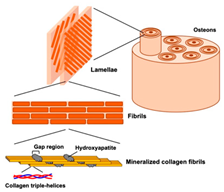 | [168,169] |
| Keratin | Found its protection for hair, nails, horns, and feathers. | Textiles, Construction |  | [170] |
| Chitin | Present in arthropods and insects as protective exoskeletons. | Healthcare, Construction | 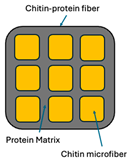 | [168,171] |
| Cellulose | Forms the structural framework (strength) of plant cell walls. | Construction, Other |  | [168,172,173] |
| Elastin | Found in skin, arteries, and lungs. Provides elasticity and resilience to tissues. | Healthcare |  | [174,175] |
| Bone | Composed of hydroxyapatite and collagen. Supports the body structurally and facilitates movement. | Healthcare, Construction | 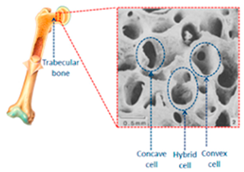 | [176,177] |
| Teeth | Includes enamel and dentin, primarily composed of hydroxyapatite. Facilitates chewing and grinding of food; protects dental nerves. | Healthcare, Dentistry |  | [166,178] |
| Abalone Shell | Hierarchical structure with aragonite tiles and organic layers. Provides toughness and fracture resistance in marine environments. | Aerospace, Construction | 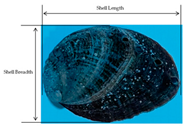 | [166,168,179] |
| Crab Exoskeleton | Composed of chitin-protein fibrils and mineralized components. Combines protection with flexibility in crustaceans. | Construction, Other |  | [166,180,181] |
| Spider Silk | Combines lightweight structure with exceptional tensile strength on strong protein fiber. | Textiles, Aerospace |  | [166,182,183,184] |
| Mussels’ Byssus | Adhesive and elastic threads for attachment to surfaces in aquatic environments. | Healthcare, Construction | 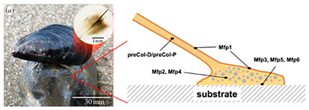 | [185,186] |
| Wood | Cellular material providing support and nutrient transport. | Construction |  | [166,187,188] |
| Feathers | Lightweight structures with mechanical and thermal properties. Insulates and supports flight in birds. | Aerospace, Textiles | 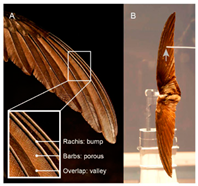 | [166,189,190] |
| Toucan Beak | Composite structure with a foam core and rigid outer shell. Provides lightweight yet strong support for feeding and defense. | Aerospace, Other | 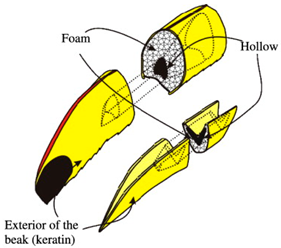 | [189,191] |
| Diatom Shells | Silica-based structures formed via self-assembly in aquatic organisms (Didymosphenia geminata) | Healthcare, Construction | 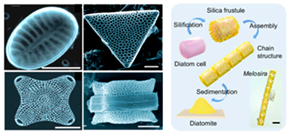 | [192,193] |
| Nacre (Mother-of-Pearl) | Composed of aragonite tiles and organic layers, providing exceptional fracture toughness and durability. | Aerospace, Construction | 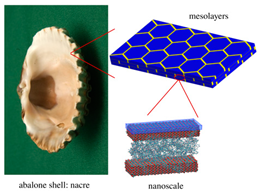 | [166,194,195,196] |
| Cactus Spines | Enable water collection through a hierarchical surface structure. | Healthcare, Construction | 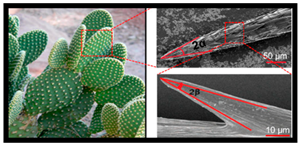 | [197] |
| Crustacean Exoskeletons | Composed of chitin-protein fibrils embedded in a mineralized matrix. Provides structural protection and flexibility. | Construction, Other |  | [198,199] |
| Mammalian Skin | Combines mechanical strength with flexibility. | Healthcare, Textiles |  | [166,200] |
| Beehive | Hexagonal cellular structure for efficient space use and strength. Provides structural efficiency and resource optimization. | Aerospace, Construction | 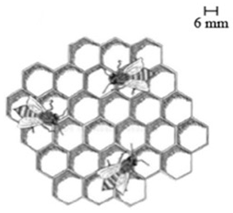 | [201] |
| Cuttlebone | Hierarchical porous and lightweight structure enabling buoyancy, resilience and protection. | Marine, Construction | 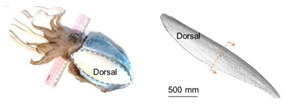 | [202,203] |
| Baleen | Keratin-based structure in whales for filtering food. | Healthcare, Other | 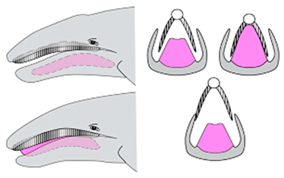 | [204] |
| Iridophores (Chameleon Skin) | Structural coloration through nanocrystals. Provides dynamic color changes for camouflage and communication. | Optics, Other |  | [205] |
| Pinecone Scales | Bilayer structure, enabling humidity-responsive movement for seed dispersal or protection. | Construction, Other |  | [206,207,208] |
| Gecko Feet | Hierarchical structure providing strong, reusable adhesion. Enables climbing and attachment on smooth surfaces. | Aerospace, Healthcare | 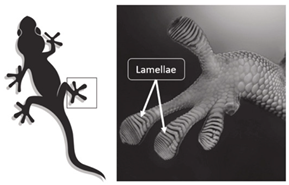 | [209,210] |
| Lotus Leaves | Surface micro textures, offering superhydrophobicity for self-cleaning and efficiency. | Healthcare, Textiles | 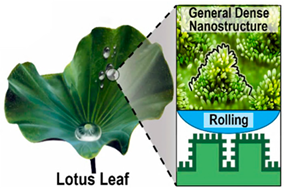 | [211] |
| Butterfly Wings | Microstructures, interacting with light for coloration without pigments. | Optics, Textiles | 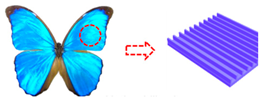 | [166,212,213] |
| Hedgehog Spines | Cellular structure for energy dissipation. Protects against impacts and predators. | Aerospace, Automotive |  | [214,215] |
7.2. Bioinspired Structures
7.3. Potential Case of Studies
8. Conclusions
9. Challenges and Limitations
10. Future Perspective
Author Contributions
Funding
Data Availability Statement
Conflicts of Interest
References and Note
- ISO/ASTM52900:2021(E); Additive Manufacturing—General Principles—Fundamentals and Vocabulary. ASTM International: West Conshohocken, PA, USA, 2022.
- Martin, J.H.; Yahata, B.D.; Hundley, J.M.; Mayer, J.A.; Schaedler, T.A.; Pollock, T.M. 3D Printing of High-Strength Aluminium Alloys. Nature 2017, 549, 365–369. [Google Scholar] [CrossRef]
- Dämmer, G.; Bauer, H.; Neumann, R.; Major, Z. Design, Additive Manufacturing and Component Testing of Pneumatic Rotary Vane Actuators for Lightweight Robots. Rapid Prototyp. J. 2022, 28, 20–32. [Google Scholar] [CrossRef]
- Munz, O.J. Photo-Glyph Recording. 1956. [Google Scholar]
- Gao, W.; Zhang, Y.; Ramanujan, D.; Ramani, K.; Chen, Y.; Williams, C.B.; Wang, C.C.L.; Shin, Y.C.; Zhang, S.; Zavattieri, P.D. The Status, Challenges, and Future of Additive Manufacturing in Engineering. Comp.-Aided Des. 2015, 69, 65–89. [Google Scholar] [CrossRef]
- Mirzaali, M.J.; Moosabeiki, V.; Rajaai, S.M.; Zhou, J.; Zadpoor, A.A. Additive Manufacturing of Biomaterials—Design Principles and Their Implementation. Materials 2022, 15, 5457. [Google Scholar] [CrossRef] [PubMed]
- Bose, S.; Vahabzadeh, S.; Bandyopadhyay, A. Bone Tissue Engineering Using 3D Printing. Mater. Today 2013, 16, 496–504. [Google Scholar] [CrossRef]
- Murr, L.E.; Gaytan, S.M.; Medina, F.; Lopez, H.; Martinez, E.; Machado, B.I.; Hernandez, D.H.; Martinez, L.; Lopez, M.I.; Wicker, R.B.; et al. Next-Generation Biomedical Implants Using Additive Manufacturing of Complex, Cellular and Functional Mesh Arrays. Philos. Tran. R. Soc. A Math. Phys. Eng. Sci. 2010, 368, 1999–2032. [Google Scholar] [CrossRef]
- Herzog, D.; Seyda, V.; Wycisk, E.; Emmelmann, C. Additive Manufacturing of Metals. Acta Mater. 2016, 117, 371–392. [Google Scholar] [CrossRef]
- Wang, K.; Xie, X.; Wang, J.; Zhao, A.; Peng, Y.; Rao, Y. Effects of Infill Characteristics and Strain Rate on the Deformation and Failure Properties of Additively Manufactured Polyamide-Based Composite Structures. Res. Phys. 2020, 18, 103346. [Google Scholar] [CrossRef]
- Ziaee, M.; Tridas, E.M.; Crane, N.B. Binder-Jet Printing of Fine Stainless Steel Powder with Varied Final Density. JOM 2017, 69, 592–596. [Google Scholar] [CrossRef]
- Gong, H.; Rafi, K.; Gu, H.; Starr, T.; Stucker, B. Analysis of Defect Generation in Ti–6Al–4V Parts Made Using Powder Bed Fusion Additive Manufacturing Processes. Addit. Manuf. 2014, 1–4, 87–98. [Google Scholar] [CrossRef]
- Raheem, A.A.; Hameed, P.; Whenish, R.; Elsen, R.S.; G, A.; Jaiswal, A.K.; Prashanth, K.G.; Manivasagam, G. A Review on Development of Bio-Inspired Implants Using 3D Printing. Biomimetics 2021, 6, 65. [Google Scholar] [CrossRef] [PubMed]
- Wang, Y.; Naleway, S.E.; Wang, B. Biological and Bioinspired Materials: Structure Leading to Functional and Mechanical Performance. Bioact. Mater. 2020, 5, 745–757. [Google Scholar] [CrossRef] [PubMed]
- Rittinghaus, S.-K.; Jägle, E.A.; Schmid, M.; Gökce, B. New Frontiers in Materials Design for Laser Additive Manufacturing. Materials 2022, 15, 6172. [Google Scholar] [CrossRef] [PubMed]
- Brancewicz-Steinmetz, E.; Sawicki, J. Bonding and Strengthening the PLA Biopolymer in Multi-Material Additive Manufacturing. Materials 2022, 15, 5563. [Google Scholar] [CrossRef]
- Karolewska, K.; Szala, G.; Trepczyńska-Łent, M.; Ligaj, B. Improving the Mechanical Properties of Structural Elements Made of Titanium, Aluminum Alloys, and Steel through the Additive Manufacturing Application. Adv. Sci. Technol. Res. J. 2024, 19, 48–71. [Google Scholar] [CrossRef] [PubMed]
- Li, J.; Liu, W.; Shen, J.; Zhang, X.; Li, S.; Wang, Z. Research Progress of the Metal Powder Reuse for Powder Bed Fusion Additive Manufacturing Technology. Powder Technol. 2024, 441, 119815. [Google Scholar] [CrossRef]
- Khan, N.; Riccio, A. A Systematic Review of Design for Additive Manufacturing of Aerospace Lattice Structures: Current Trends and Future Directions. Prog. Aerosp. Sci. 2024, 149, 101021. [Google Scholar] [CrossRef]
- Yang, Y.; Jiang, R.; Han, C.; Chen, J.; Li, H.; Wang, Y.; Tang, J.; Zhou, H.; Hu, W.; Zheng, B.; et al. Frontiers in Laser Additive Manufacturing Technology. Addit. Manuf. Front. 2024, 3, 200160. [Google Scholar] [CrossRef]
- Ratkus, A.; Rarison, S.; Garion, C.; Kos, H.; Gruber, S.; Stepien, L.; Patil, A.A.; Lopez, E.; Torims, T.; Pikurs, G.; et al. Evaluation of Green Laser Source Additive Manufacturing Technology for Accelerator Applications with Ultra-High Vacuum Requirements. J. Phys. Conf. Ser. 2024, 2687, 082046. [Google Scholar] [CrossRef]
- Baroutaji, A.; Arjunan, A.; Robinson, J.; Abdelkareem, M.A.; Olabi, A.-G. Additive Manufacturing for Proton Exchange Membrane (PEM) Hydrogen Technologies: Merits, Challenges, and Prospects. Int. J. Hydrogen Energy 2024, 52, 561–584. [Google Scholar] [CrossRef]
- Jin, L.; Zhai, X.; Wang, K.; Zhang, K.; Wu, D.; Nazir, A.; Jiang, J.; Liao, W.-H. Big Data, Machine Learning, and Digital Twin Assisted Additive Manufacturing: A Review. Mater. Des. 2024, 244, 113086. [Google Scholar] [CrossRef]
- Pourkamali-Anaraki, F.; Nasrin, T.; Jensen, R.E.; Peterson, A.M.; Hansen, C.J. Evaluation of Classification Models in Limited Data Scenarios with Application to Additive Manufacturing. Eng. Appl. Artif. Intell. 2023, 126, 106983. [Google Scholar] [CrossRef]
- Bechmann, F. Changing the Future of Additive Manufacturing. Met. Powder Rep. 2014, 69, 37–40. [Google Scholar] [CrossRef]
- Eyers, D.R.; Potter, A.T. Industrial Additive Manufacturing: A Manufacturing Systems Perspective. Comput. Ind. 2017, 92–93, 208–218. [Google Scholar] [CrossRef]
- Tian, X.; Wu, L.; Gu, D.; Yuan, S.; Zhao, Y.; Li, X.; Ouyang, L.; Song, B.; Gao, T.; He, J.; et al. Roadmap for Additive Manufacturing: Toward Intellectualization and Industrialization. Chin. J. Mech. Eng. Addit. Manuf. Front. 2022, 1, 100014. [Google Scholar] [CrossRef]
- Horn, T.J.; Harrysson, O.L.A. Overview of Current Additive Manufacturing Technologies and Selected Applications. Sci. Prog. 2012, 95, 255–282. [Google Scholar] [CrossRef] [PubMed]
- Monteiro, H.; Carmona-Aparicio, G.; Lei, I.; Despeisse, M. Energy and Material Efficiency Strategies Enabled by Metal Additive Manufacturing—A Review for the Aeronautic and Aerospace Sectors. Energy Rep. 2022, 8, 298–305. [Google Scholar] [CrossRef]
- Ngo, T.D.; Kashani, A.; Imbalzano, G.; Nguyen, K.T.Q.; Hui, D. Additive Manufacturing (3D Printing): A Review of Materials, Methods, Applications and Challenges. Compos. B Eng. 2018, 143, 172–196. [Google Scholar] [CrossRef]
- Rejeski, D.; Zhao, F.; Huang, Y. Research Needs and Recommendations on Environmental Implications of Additive Manufacturing. Addit. Manuf. 2018, 19, 21–28. [Google Scholar] [CrossRef]
- Balubaid, M.; Alsaadi, N. Achieving Sustainability in Manufacturing through Additive Manufacturing: An Analysis of Its Enablers. Sustainability 2023, 15, 9504. [Google Scholar] [CrossRef]
- Gonçalves, A.; Ferreira, B.; Leite, M.; Ribeiro, I. Environmental and Economic Sustainability Impacts of Metal Additive Manufacturing: A Study in the Industrial Machinery and Aeronautical Sectors. Sustain. Prod. Consum. 2023, 42, 292–308. [Google Scholar] [CrossRef]
- Garcia-Gonzalez, H.; Lopez-Pola, T.; Fernandez-Rubio, P.; Fernandez-Rodriguez, P. Analysis of Volatile Organic Compound Emissions in 3D Printing: Implications for Indoor Air Quality. Buildings 2024, 14, 3343. [Google Scholar] [CrossRef]
- Zhang, Q.; Black, M.S. Exposure Hazards of Particles and Volatile Organic Compounds Emitted from Material Extrusion 3D Printing: Consolidation of Chamber Study Data. Environ. Int. 2023, 182, 108316. [Google Scholar] [CrossRef] [PubMed]
- Zhang, Q.; Davis, A.Y.; Black, M.S. Emissions and Chemical Exposure Potentials from Stereolithography Vat Polymerization 3D Printing and Post-Processing Units. ACS Chem. Health Saf. 2022, 29, 184–191. [Google Scholar] [CrossRef]
- Väisänen, A.; Alonen, L.; Ylönen, S.; Hyttinen, M. Volatile Organic Compound and Particulate Emissions from the Production and Use of Thermoplastic Biocomposite 3D Printing Filaments. J. Occup. Environ. Hyg. 2022, 19, 381–393. [Google Scholar] [CrossRef]
- Gibbons, D.W.; Govender, P.; van der Merwe, A.F. Metal Powder Feedstock Evaluation and Management for Powder Bed Fusion: A Review of Literature, Standards, and Practical Guidelines. Prog. Addit. Manuf. 2024, 9, 805–833. [Google Scholar] [CrossRef]
- Giganto, S.; Martínez-Pellitero, S.; Barreiro, J.; Zapico, P. Influence of 17-4 PH Stainless Steel Powder Recycling on Properties of SLM Additive Manufactured Parts. J. Mater. Res. Technol. 2022, 16, 1647–1658. [Google Scholar] [CrossRef]
- Aly, R.; Olalere, O.; Ryder, A.; Alyammahi, M.; Samad, W.A. Mechanical Property Characterization of Virgin and Recycled PLA Blends in Single-Screw Filament Extrusion for 3D Printing. Polymers 2024, 16, 3569. [Google Scholar] [CrossRef] [PubMed]
- Tănase, M.; Portoacă, A.I.; Diniță, A.; Brănoiu, G.; Zamfir, F.; Sirbu, E.-E.; Călin, C. Optimizing Mechanical Properties of Recycled 3D-Printed PLA Parts for Sustainable Packaging Solutions Using Experimental Analysis and Machine Learning. Polymers 2024, 16, 3268. [Google Scholar] [CrossRef]
- de Sousa Alves, B.A.; Kontziampasis, D.; Soliman, A.-H. The Quest for the Holy Grail Of 3D Printing: A Critical Review of Recycling in Polymer Powder Bed Fusion Additive Manufacturing. Polymers 2024, 16, 2306. [Google Scholar] [CrossRef]
- Yang, S.; Min, W.; Ghibaudo, J.; Zhao, Y.F. Understanding the Sustainability Potential of Part Consolidation Design Supported by Additive Manufacturing. J. Clean. Prod. 2019, 232, 722–738. [Google Scholar] [CrossRef]
- Kellens, K.; Baumers, M.; Gutowski, T.G.; Flanagan, W.; Lifset, R.; Duflou, J.R. Environmental Dimensions of Additive Manufacturing: Mapping Application Domains and Their Environmental Implications. J. Ind. Ecol. 2017, 21, S49–S68. [Google Scholar] [CrossRef]
- ZainElabdeen, I.H.; Ismail, L.; Mohamed, O.F.; Khan, K.A.; Schiffer, A. Recent Advancements in Hybrid Additive Manufacturing of Similar and Dissimilar Metals via Laser Powder Bed Fusion. Mater. Sci. Eng. A 2024, 909, 146833. [Google Scholar] [CrossRef]
- Mirzababaei, S.; Pasebani, S. A Review on Binder Jet Additive Manufacturing of 316L Stainless Steel. J. Manuf. Mater. Process 2019, 3, 82. [Google Scholar] [CrossRef]
- Do, T.; Bauder, T.J.; Suen, H.; Rego, K.; Yeom, J.; Kwon, P. Additively Manufactured Full-Density Stainless Steel 316L with Binder Jet Printing. In Proceedings of the ASME 2018 13th International Manufacturing Science and Engineering Conference, College Station, TX, USA, 18–22 June 2018; Volume 1: Additive Manufacturing; Bio and Sustainable Manufacturing. American Society of Mechanical Engineers: New York, NY, USA, 2018; Volume 51357, p. V001T01A017. [Google Scholar]
- Ellis, A.; Noble, C.J.; Hopkinson, N. High Speed Sintering: Assessing the Influence of Print Density on Microstructure and Mechanical Properties of Nylon Parts. Addit. Manuf. 2014, 1–4, 48–51. [Google Scholar] [CrossRef]
- Utela, B.; Storti, D.; Anderson, R.; Ganter, M. A Review of Process Development Steps for New Material Systems in Three Dimensional Printing (3DP). J. Manuf. Process. 2008, 10, 96–104. [Google Scholar] [CrossRef]
- Sæterbø, M.; Solvang, W.D. Metal Additive Manufacturing Adoption in SMEs: Technical Attributes, Challenges, and Opportunities. J. Manuf. Process. 2024, 128, 175–189. [Google Scholar] [CrossRef]
- Çam, G. Prospects of Producing Aluminum Parts by Wire Arc Additive Manufacturing (WAAM). Mater. Today Proc. 2022, 62, 77–85. [Google Scholar] [CrossRef]
- Farabi, E.; Babaniaris, S.; Barnett, M.R.; Fabijanic, D.M. Microstructure and Mechanical Properties of Ti6Al4V Alloys Fabricated by Additive Friction Stir Deposition. Addit. Manuf. Lett. 2022, 2, 100034. [Google Scholar] [CrossRef]
- Kaji, F.; Jinoop, A.N.; Zimny, M.; Frikel, G.; Tam, K.; Toyserkani, E. Process Planning for Additive Manufacturing of Geometries with Variable Overhang Angles Using a Robotic Laser Directed Energy Deposition System. Addit. Manuf. Lett. 2022, 2, 100035. [Google Scholar] [CrossRef]
- Hassanifard, S.; Behdinan, K. Fatigue Response of Multiscale Extrusion-Based Additively Manufactured Acrylonitrile Butadiene Styrene-Graphene Nanoplatelets Composites. Compos. B Eng. 2024, 279, 111464. [Google Scholar] [CrossRef]
- Nohut, S.; Schwentenwein, M. Vat Photopolymerization Additive Manufacturing of Functionally Graded Materials: A Review. J. Manuf. Mater. Process. 2022, 6, 17. [Google Scholar] [CrossRef]
- Srivastava, M.; Rathee, S.; Patel, V.; Kumar, A.; Koppad, P.G. A Review of Various Materials for Additive Manufacturing: Recent Trends and Processing Issues. J. Mater. Res. Technol. 2022, 21, 2612–2641. [Google Scholar] [CrossRef]
- Kharmanda, G. Additive Manufacturing of Polylactic Acid (PLA) Material Considering Preheating Uncertainty Effect. Uncertainties Reliab. Multiphysical Syst. 2022, 6, 1–11. [Google Scholar] [CrossRef]
- Gülcan, O.; Günaydın, K.; Tamer, A. The State of the Art of Material Jetting—A Critical Review. Polymers 2021, 13, 2829. [Google Scholar] [CrossRef] [PubMed]
- Sugavaneswaran, M.; Arumaikkannu, G. Modelling for Randomly Oriented Multi Material Additive Manufacturing Component and Its Fabrication. Mater. Des. (1980–2015) 2014, 54, 779–785. [Google Scholar] [CrossRef]
- Afridi, A.; Al Rashid, A.; Koç, M. Recent Advances in the Development of Stereolithography-Based Additive Manufacturing Processes: A Review of Applications and Challenges. Bioprinting 2024, 43, e00360. [Google Scholar] [CrossRef]
- Gibson, I.; Rosen, D.; Stucker, B. Additive Manufacturing Technologies: 3D Printing, Rapid Prototyping, and Direct Digital Manufacturing; Springer: New York, NY, USA, 2015; ISBN 978-1-4939-2112-6. [Google Scholar]
- Drummer, D.; Wudy, K.; Drexler, M. Influence of Energy Input on Degradation Behavior of Plastic Components Manufactured by Selective Laser Melting. Phys. Procedia 2014, 56, 176–183. [Google Scholar] [CrossRef]
- Kruth, J.P.; Levy, G.; Klocke, F.; Childs, T.H.C. Consolidation Phenomena in Laser and Powder-Bed Based Layered Manufacturing. CIRP Ann. 2007, 56, 730–759. [Google Scholar] [CrossRef]
- DebRoy, T.; Wei, H.L.; Zuback, J.S.; Mukherjee, T.; Elmer, J.W.; Milewski, J.O.; Beese, A.M.; Wilson-Heid, A.; De, A.; Zhang, W. Additive Manufacturing of Metallic Components—Process, Structure and Properties. Prog. Mater. Sci. 2018, 92, 112–224. [Google Scholar] [CrossRef]
- Frazier, W.E. Metal Additive Manufacturing: A Review. J. Mater. Eng. Perform. 2014, 23, 1917–1928. [Google Scholar] [CrossRef]
- Carter, L.N.; Wang, X.; Read, N.; Khan, R.; Aristizabal, M.; Essa, K.; Attallah, M.M. Process Optimisation of Selective Laser Melting Using Energy Density Model for Nickel Based Superalloys. Mater. Sci. Technol. 2016, 32, 657–661. [Google Scholar] [CrossRef]
- Tammas-Williams, S.; Zhao, H.; Léonard, F.; Derguti, F.; Todd, I.; Prangnell, P.B. XCT Analysis of the Influence of Melt Strategies on Defect Population in Ti–6Al–4V Components Manufactured by Selective Electron Beam Melting. Mater. Charact. 2015, 102, 47–61. [Google Scholar] [CrossRef]
- Goodridge, R.D.; Tuck, C.J.; Hague, R.J.M. Laser Sintering of Polyamides and Other Polymers. Prog. Mater. Sci. 2012, 57, 229–267. [Google Scholar] [CrossRef]
- Willems, J.; Megahed, M. A Numerical Formalism towards Finding a Good Component Orientation in Laser Powder Bed Fusion. Addit. Manuf. Lett. 2022, 2, 100031. [Google Scholar] [CrossRef]
- Wysocki, B.; Maj, P.; Sitek, R.; Buhagiar, J.; Kurzydłowski, K.; Święszkowski, W. Laser and Electron Beam Additive Manufacturing Methods of Fabricating Titanium Bone Implants. App Sci. 2017, 7, 657. [Google Scholar] [CrossRef]
- Park, S.; Shou, W.; Makatura, L.; Matusik, W.; Fu, K. (Kelvin) 3D Printing of Polymer Composites: Materials, Processes, and Applications. Matter 2022, 5, 43–76. [Google Scholar] [CrossRef]
- Uhlmann, E.; Fleck, C.; Gerlitzky, G.; Faltin, F. Dynamical Fatigue Behavior of Additive Manufactured Products For a Fundamental Life Cycle Approach. Procedia CIRP 2017, 61, 588–593. [Google Scholar] [CrossRef]
- Ran, J.; Jiang, F.; Sun, X.; Chen, Z.; Tian, C.; Zhao, H. Microstructure and Mechanical Properties of Ti-6Al-4V Fabricated by Electron Beam Melting. Crystals 2020, 10, 972. [Google Scholar] [CrossRef]
- Azam, M.U.; Belyamani, I.; Schiffer, A.; Kumar, S.; Askar, K. Progress in Selective Laser Sintering Ofmultifunctional Polymer Composites for Strain- and Self-Sensing Applications. J. Mater. Res. Technol. 2024, 30, 9625–9646. [Google Scholar] [CrossRef]
- Jadhav, A.; Jadhav, V.S. A Review on 3D Printing: An Additive Manufacturing Technology. Mater. Today Proc. 2022, 62, 2094–2099. [Google Scholar] [CrossRef]
- Alami, A.H.; Ghani Olabi, A.; Alashkar, A.; Alasad, S.; Aljaghoub, H.; Rezk, H.; Abdelkareem, M.A. Additive Manufacturing in the Aerospace and Automotive Industries: Recent Trends and Role in Achieving Sustainable Development Goals. Ain Shams Eng. J. 2023, 14, 102516. [Google Scholar] [CrossRef]
- Buchanan, C.; Gardner, L. Metal 3D Printing in Construction: A Review of Methods, Research, Applications, Opportunities and Challenges. Eng. Struct. 2019, 180, 332–348. [Google Scholar] [CrossRef]
- Baroutaji, A.; Arjunan, A.; Robinson, J.; Ramadan, M.; Abdelkareem, M.A.; Vance, A.; Arafat, A.; Olabi, A.G. Developments and Prospects of Additive Manufacturing for Thermoelectric Materials and Technologies. Sustain. Mater. Technol. 2024, 41, e01008. [Google Scholar] [CrossRef]
- Liao, Y.S.; Chiu, L.C.; Chiu, Y.Y. A New Approach of Online Waste Removal Process for Laminated Object Manufacturing (LOM). J. Mater. Process. Technol. 2003, 140, 136–140. [Google Scholar] [CrossRef]
- Joseph, A.; Uthirapathy, V. A Systematic Review of the Contribution of Additive Manufacturing toward Orthopedic Applications. ACS Omega 2024, 9, 44042–44075. [Google Scholar] [CrossRef] [PubMed]
- Pattnaik, A.; Sanket, A.S.; Pradhan, S.; Sahoo, R.; Das, S.; Pany, S.; Douglas, T.E.L.; Dandela, R.; Liu, Q.; Rajadas, J.; et al. Designing of Gradient Scaffolds and Their Applications in Tissue Regeneration. Biomaterials 2023, 296, 122078. [Google Scholar] [CrossRef] [PubMed]
- Praveena, B.A.; Lokesh, N.; Buradi, A.; Santhosh, N.; Praveena, B.L.; Vignesh, R. A Comprehensive Review of Emerging Additive Manufacturing (3D Printing Technology): Methods, Materials, Applications, Challenges, Trends and Future Potential. Mater. Today Proc. 2022, 52, 1309–1313. [Google Scholar] [CrossRef]
- Al Rashid, A.; Ahmed, W.; Khalid, M.Y.; Koç, M. Vat Photopolymerization of Polymers and Polymer Composites: Processes and Applications. Addit. Manuf. 2021, 47, 102279. [Google Scholar] [CrossRef]
- Shah, M.; Ullah, A.; Azher, K.; Rehman, A.U.; Juan, W.; Aktürk, N.; Tüfekci, C.S.; Salamci, M.U. Vat Photopolymerization-Based 3D Printing of Polymer Nanocomposites: Current Trends and Applications. RSC Adv. 2023, 13, 1456–1496. [Google Scholar] [CrossRef] [PubMed]
- Çerlek, Ö.; Muhammed, A.; Kesercioğlu, M.; Han, K. Stereolithography(SLA): An Innovative Additive Manufacturing Process. In New Trends and Frontiers in Engineering; All Sciences Academy: Konya, Turkey, 2024; p. 401. ISBN 978-625-6314-57-3. [Google Scholar]
- Gao, W.; Guo, Y.; Cui, J.; Liang, C.; Lu, Z.; Feng, S.; Sun, Y.; Xia, Q.; Zhang, B. Dual-Curing Polymer Systems for Photo-Curing 3D Printing. Addit. Manuf. 2024, 85, 104142. [Google Scholar] [CrossRef]
- Coșa, A.-V.; Baban, M.-V.; Șerban, D.-A. Influence of Curing Time and Temperature on the Mechanical Properties of Resins Manufactured through Stereolithography. IOP Conf. Ser. Mater. Sci. Eng. 2024, 1319, 012020. [Google Scholar] [CrossRef]
- Colorado, H.A.; Gutierrez-Velasquez, E.I.; Gil, L.D.; de Camargo, I.L. Exploring the Advantages and Applications of Nanocomposites Produced via Vat Photopolymerization in Additive Manufacturing: A Review. Adv. Compos. Hybrid. Mater. 2024, 7, 1. [Google Scholar] [CrossRef]
- Cabrera-Moreta, V.H.; Casals-Terré, J.; Salguero, E. Validation of Fluid Flow Speed Behavior in Capillary Microchannels Using Additive Manufacturing (SLA Technology). Processes 2024, 12, 1066. [Google Scholar] [CrossRef]
- Ren, L.; Wang, Z.; Ren, L.; Han, Z.; Liu, Q.; Song, Z. Graded Biological Materials and Additive Manufacturing Technologies for Producing Bioinspired Graded Materials: An Overview. Compos. B Eng. 2022, 242, 110086. [Google Scholar] [CrossRef]
- Gobena, S.T.; Woldeyohannes, A.D. Comparative Review on the Application of Smart Material in Additive Manufacturing: 3D and 4D Printing. Dis. App Sci. 2024, 6, 353. [Google Scholar]
- Franco Urquiza, E.A. Advances in Additive Manufacturing of Polymer-Fused Deposition Modeling on Textiles: From 3D Printing to Innovative 4D Printing—A Review. Polymers 2024, 16, 700. [Google Scholar] [CrossRef]
- Lu, X.; Liu, G.; Lu, J. Development of Ceramic 3D/4D Printing in China. Addit. Manuf. Front. 2024, 3, 200158. [Google Scholar] [CrossRef]
- Etawy, M.; Nassar, G.; Mohammed, N.; Nawar, S.; Hassabo, A. 4D Printing of Stimuli-Responsive Materials. J. Text. Color. Polym. Sci. 2024, 2, 241–258. [Google Scholar] [CrossRef]
- Qiu, W.; Xu, X.; Dong, K.; Wang, Y.; Xiong, Y. Recent Advances in 4D Printing of Fiber-Reinforced Polymer Composites: A Review and Outlook. Compos. B Eng. 2024, 283, 111645. [Google Scholar] [CrossRef]
- Sajjad, R.; Chauhdary, S.T.; Anwar, M.T.; Zahid, A.; Khosa, A.A.; Imran, M.; Sajjad, M.H. A Review of 4D Printing—Technologies, Shape Shifting, Smart Polymer Based Materials, and Biomedical Applications. Adv. Ind. Eng. Polym. Res. 2024, 7, 20–36. [Google Scholar] [CrossRef]
- Singh, T.; Kumar, S.; Sehgal, S. 3D Printing of Engineering Materials: A State of the Art Review. Mater. Today Proc. 2020, 28, 1927–1931. [Google Scholar] [CrossRef]
- Chen, J.V.; Dang, A.B.C.; Dang, A. Comparing Cost and Print Time Estimates for Six Commercially-Available 3D Printers Obtained through Slicing Software for Clinically Relevant Anatomical Models. 3D Print. Med. 2021, 7, 1. [Google Scholar] [CrossRef]
- Alogla, A.A.; Baumers, M.; Tuck, C.; Elmadih, W. The Impact of Additive Manufacturing on the Flexibility of a Manufacturing Supply Chain. App Sci. 2021, 11, 3707. [Google Scholar] [CrossRef]
- Hyer, H.C.; Massey, C.P.; Chappell, J.; Garrison, B.; Parish, C.; Seibert, R.; Smith, K.; Nelson, A. High Plasticity in Refractory Composite Fabrication by Ultrasonic Additive Manufacturing. Compos. B Eng. 2025, 292, 112051. [Google Scholar] [CrossRef]
- Kafle, A.; Luis, E.; Silwal, R.; Pan, H.M.; Shrestha, P.L.; Bastola, A.K. 3D/4D Printing of Polymers: Fused Deposition Modelling (FDM), Selective Laser Sintering (SLS), and Stereolithography (SLA). Polymers 2021, 13, 3101. [Google Scholar] [CrossRef] [PubMed]
- Wohlers, T. Wohlers Report 2024: 3D Printing and Additive Manufacturing: Global State of the Industry; ASTM International, Ed.; Wohlers Associates: Fort Collins, CO, USA, 2024. [Google Scholar]
- Jin, J.; Wu, S.; Yang, L.; Zhang, C.; Li, Y.; Cai, C.; Yan, C.; Shi, Y. Ni–Ti Multicell Interlacing Gyroid Lattice Structures with Ultra-High Hyperelastic Response Fabricated by Laser Powder Bed Fusion. Int. J. Mach. Tools Manuf. 2024, 195, 104099. [Google Scholar] [CrossRef]
- Ashby, M.F. Introduction. In Materials Selection in Mechanical Design, 4th ed.; Elsevier Ltd.: Amsterdam, The Netherlands, 2011; pp. 1–13. [Google Scholar] [CrossRef]
- Wang, Y.M.; Voisin, T.; McKeown, J.T.; Ye, J.; Calta, N.P.; Li, Z.; Zeng, Z.; Zhang, Y.; Chen, W.; Roehling, T.T.; et al. Additively Manufactured Hierarchical Stainless Steels with High Strength and Ductility. Nat. Mater. 2018, 17, 63–71. [Google Scholar] [CrossRef] [PubMed]
- Li, X.; Yao, F.; Guo, H.; Li, J. Experimental Research on the Effects of the Laser Energy Density on the Morphology, Phase, Microstructure and Properties of Q345D/20Mn2 Dissimilar Steel Filler Welding Joints. J. Adhes. Sci. Technol. 2024, 39, 167–187. [Google Scholar] [CrossRef]
- Abd-Elghany, K.; Bourell, D.L. Property Evaluation of 304L Stainless Steel Fabricated by Selective Laser Melting. Rapid Prototyp. J. 2012, 18, 420–428. [Google Scholar] [CrossRef]
- Cheruvathur, S.; Lass, E.A.; Campbell, C.E. Additive Manufacturing of 17-4 PH Stainless Steel: Post-Processing Heat Treatment to Achieve Uniform Reproducible Microstructure. JOM 2016, 68, 930–942. [Google Scholar] [CrossRef] [PubMed]
- Roberts, D.; Zhang, Y.; Charit, I.; Zhang, J. A Comparative Study of Microstructure and High-Temperature Mechanical Properties of 15-5 PH Stainless Steel Processed via Additive Manufacturing and Traditional Manufacturing. Prog. Addit. Manuf. 2018, 3, 183–190. [Google Scholar] [CrossRef]
- Anwar, A.B.; Pham, Q.C. Selective Laser Melting of AlSi10Mg: Effects of Scan Direction, Part Placement and Inert Gas Flow Velocity on Tensile Strength. J. Mater. Process. Technol. 2017, 240, 388–396. [Google Scholar] [CrossRef]
- Thijs, L.; Kempen, K.; Kruth, J.P.; Van Humbeeck, J. Fine-Structured Aluminium Products with Controllable Texture by Selective Laser Melting of Pre-Alloyed AlSi10Mg Powder. Acta Mater. 2013, 61, 1809–1819. [Google Scholar] [CrossRef]
- Gunenthiram, V.; Peyre, P.; Schneider, M.; Dal, M.; Coste, F.; Koutiri, I.; Fabbro, R. Experimental Analysis of Spatter Generation and Melt-Pool Behavior during the Powder Bed Laser Beam Melting Process. J. Mater. Process. Technol. 2018, 251, 376–386. [Google Scholar] [CrossRef]
- Qiu, C.; Panwisawas, C.; Ward, M.; Basoalto, H.C.; Brooks, J.W.; Attallah, M.M. On the Role of Melt Flow into the Surface Structure and Porosity Development during Selective Laser Melting. Acta Mater. 2015, 96, 72–79. [Google Scholar] [CrossRef]
- Harrysson, O.L.A.; Marcellin-Little, D.J.; Horn, T.J. Applications of Metal Additive Manufacturing in Veterinary Orthopedic Surgery. JOM 2015, 67, 647–654. [Google Scholar] [CrossRef]
- Liu, P.; Wang, Z.; Xiao, Y.; Horstemeyer, M.F.; Cui, X.; Chen, L. Insight into the Mechanisms of Columnar to Equiaxed Grain Transition during Metallic Additive Manufacturing. Addit. Manuf. 2019, 26, 22–29. [Google Scholar] [CrossRef]
- Liu, Z.; Zhao, D.; Wang, P.; Yan, M.; Yang, C.; Chen, Z.; Lu, J.; Lu, Z. Additive Manufacturing of Metals: Microstructure Evolution and Multistage Control. J. Mater. Sci. Technol. 2022, 100, 224–236. [Google Scholar] [CrossRef]
- Aboulkhair, N.T.; Simonelli, M.; Parry, L.; Ashcroft, I.; Tuck, C.; Hague, R. 3D Printing of Aluminium Alloys: Additive Manufacturing of Aluminium Alloys Using Selective Laser Melting. Prog. Mater. Sci. 2019, 106, 100578. [Google Scholar] [CrossRef]
- Kong, D.; Dong, C.; Wei, S.; Ni, X.; Zhang, L.; Li, R.; Wang, L.; Man, C.; Li, X. About Metastable Cellular Structure in Additively Manufactured Austenitic Stainless Steels. Addit. Manuf. 2021, 38, 101804. [Google Scholar] [CrossRef]
- Sarabia-Vallejos, M.A.; Rodríguez-Umanzor, F.E.; González-Henríquez, C.M.; Rodríguez-Hernández, J. Innovation in Additive Manufacturing Using Polymers: A Survey on the Technological and Material Developments. Polymers 2022, 14, 1351. [Google Scholar] [CrossRef]
- Vasquez, G.M.; Majewski, C.E.; Haworth, B.; Hopkinson, N. A Targeted Material Selection Process for Polymers in Laser Sintering. Addit. Manuf. 2014, 1–4, 127–138. [Google Scholar] [CrossRef]
- Rajakaruna, R.A.D.N.V.; Subeshan, B.; Asmatulu, E. Fabrication of Hydrophobic PLA Filaments for Additive Manufacturing. J. Mater. Sci. 2022, 57, 8987–9001. [Google Scholar] [CrossRef] [PubMed]
- Chong, W.J.; Shen, S.; Li, Y.; Trinchi, A.; Pejak, D.; (Louis) Kyratzis, I.; Sola, A.; Wen, C. Additive Manufacturing of Antibacterial PLA-ZnO Nanocomposites: Benefits, Limitations and Open Challenges. J. Mater. Sci. Technol. 2022, 111, 120–151. [Google Scholar] [CrossRef]
- Vaezi, M.; Seitz, H.; Yang, S. A Review on 3D Micro-Additive Manufacturing Technologies. Int. J. Adv. Manuf. Technol. 2013, 67, 1721–1754. [Google Scholar] [CrossRef]
- Madhavadas, V.; Srivastava, D.; Chadha, U.; Aravind Raj, S.; Sultan, M.T.H.; Shahar, F.S.; Shah, A.U.M. A Review on Metal Additive Manufacturing for Intricately Shaped Aerospace Components. CIRP J. Manuf. Sci. Technol. 2022, 39, 18–36. [Google Scholar] [CrossRef]
- Costanza, G.; Tata, M.E. Shape Memory Alloys for Aerospace, Recent Developments, and New Applications: A Short Review. Materials 2020, 13, 1856. [Google Scholar] [CrossRef] [PubMed]
- Bodaghi, M.; Wang, L.; Zhang, F.; Liu, Y.; Leng, J.; Xing, R.; Dickey, M.D.; Vanaei, S.; Elahinia, M.; Van Hoa, S.; et al. 4D Printing Roadmap. Smart Mater. Struct. 2024, 33, 113501. [Google Scholar] [CrossRef]
- Li, Z.; Cao, Z.; Zhao, Q.; Mei, S.; Zhang, Y.; Zhao, W.; Li, X.; Zhang, X.; Cui, Z.; Fu, P.; et al. Self-Healing and Shape Memory Reconfigurable Poly(Urethane-Urea-Amide) Elastomers Containing Multiple Dynamic Bonds for Improving Performance of 4D Printout. Chem. Eng. J. 2024, 485, 149933. [Google Scholar] [CrossRef]
- González-Henríquez, C.M.; Sarabia-Vallejos, M.A.; Rodriguez-Hernandez, J. Polymers for Additive Manufacturing and 4D-Printing: Materials, Methodologies, and Biomedical Applications. Prog. Polym. Sci. 2019, 94, 57–116. [Google Scholar] [CrossRef]
- Zafar, M.Q.; Zhao, H. 4D Printing: Future Insight in Additive Manufacturing. Met. Mater. Int. 2020, 26, 564–585. [Google Scholar] [CrossRef]
- Mehrpouya, M.; Alberto Biffi, C.; Lemke, J.N.; Bregoli, C.; Fiocchi, J.; Mohajerani, S.; Tuissi, A.; Elahinia, M. Additive Manufacturing of Architected Shape Memory Alloys: A Review. Virtual Phys. Prototyp. 2024, 19, e2414395. [Google Scholar] [CrossRef]
- Fonda, R.W.; Jones, H.N.; Vandermeer, R.A. The Shape Memory Effect in Equiatomic TaRu and NbRu Alloys. Scr. Mater. 1998, 39, 1031–1037. [Google Scholar] [CrossRef]
- Kubášová, K.; Drátovská, V.; Losertová, M.; Salvetr, P.; Kopelent, M.; Kořínek, F.; Havlas, V.; Džugan, J.; Daniel, M. A Review on Additive Manufacturing Methods for NiTi Shape Memory Alloy Production. Materials 2024, 17, 1248. [Google Scholar] [CrossRef] [PubMed]
- Xue, L.; Atli, K.C.; Zhang, C.; Hite, N.; Srivastava, A.; Leff, A.C.; Wilson, A.A.; Sharar, D.J.; Elwany, A.; Arroyave, R.; et al. Laser Powder Bed Fusion of Defect-Free NiTi Shape Memory Alloy Parts with Superior Tensile Superelasticity. Acta Mater. 2022, 229, 117781. [Google Scholar] [CrossRef]
- Ahmad, S.; Hashmi, A.W.; Singh, J.; Arora, K.; Tian, Y.; Iqbal, F.; Al-Dossari, M.; Khan, M.I. Innovations in Additive Manufacturing of Shape Memory Alloys: Alloys, Microstructures, Treatments, Applications. J. Mater. Res. Technol. 2024, 32, 4136–4197. [Google Scholar] [CrossRef]
- Alagha, A.N.; Hussain, S.; Zaki, W. Additive Manufacturing of Shape Memory Alloys: A Review with Emphasis on Powder Bed Systems. Mater. Des. 2021, 204, 109654. [Google Scholar] [CrossRef]
- Xi, R.; Jiang, H.; Li, G.; Zhang, Z.; Zhao, G.; Vanmeensel, K.; Kustov, S.; Van Humbeeck, J.; Wang, X. Effect of Fe Addition on the Microstructure, Transformation Behaviour and Superelasticity of NiTi Alloys Fabricated by Laser Powder Bed Fusion. Virtual Phys. Prototyp. 2023, 18, e2126376. [Google Scholar] [CrossRef]
- Hsu, D.H.D.; Hornbuckle, B.C.; Valderrama, B.; Barrie, F.; Henderson, H.B.; Thompson, G.B.; Manuel, M.V. The Effect of Aluminum Additions on the Thermal, Microstructural, and Mechanical Behavior of NiTiHf Shape Memory Alloys. J. Alloys Compd. 2015, 638, 67–76. [Google Scholar] [CrossRef]
- Dong, K.; Sun, L.; Zhang, Z.; Li, Z.; Li, J.; Liu, L.; Du, K.; Zhang, Y. Effects of V Addition on Microstructure and Pseudoelastic Response in Fe–Mn–Al–Ni Alloys. Intermetallics 2023, 160, 107954. [Google Scholar] [CrossRef]
- Tian, B.; Jiang, Y.L.; Chen, F.; Tong, Y.X.; Li, L.; Zheng, Y.F. Effect of Zr Addition on the Microstructure, Phase Transformation and Mechanical Property of Ni50Mn25Ga17Cu8 Alloy. Mater. Sci. Eng. A 2014, 617, 46–51. [Google Scholar] [CrossRef]
- Jiang, H.; Wang, C.; Xu, W.; Xu, X.; Yang, S.; Kainuma, R.; Liu, X. Alloying Effects of Ga on the Co-V-Si High-Temperature Shape Memory Alloys. Mater. Des. 2017, 116, 300–308. [Google Scholar] [CrossRef]
- Salvetr, P.; Školáková, A.; Novák, P.; Vavřík, J. Effect of Si Addition on Martensitic Transformation and Microstructure of NiTiSi Shape Memory Alloys. Metall. Mater. Trans. A 2020, 51, 4434–4438. [Google Scholar] [CrossRef]
- Yousaf, A.; Al Rashid, A.; Polat, R.; Koç, M. Potential and Challenges of Recycled Polymer Plastics and Natural Waste Materials for Additive Manufacturing. Sust. Mater. Technol. 2024, 41, e01103. [Google Scholar] [CrossRef]
- ElHassan, A.; Ahmed, W.; Zaneldin, E. A Comparative Investigation of the Reliability of Biodegradable Components Produced through Additive Manufacturing Technology. Polymers 2024, 16, 615. [Google Scholar] [CrossRef]
- Karamzadeh, V.; Shen, M.L.; Ravanbakhsh, H.; Sohrabi-Kashani, A.; Okhovatian, S.; Savoji, H.; Radisic, M.; Juncker, D. High-Resolution Additive Manufacturing of a Biodegradable Elastomer with A Low-Cost LCD 3D Printer. Adv. Healthc. Mater. 2024, 13, 2303708. [Google Scholar] [CrossRef] [PubMed]
- Romani, A.; Perusin, L.; Ciurnelli, M.; Levi, M. Characterization of PLA Feedstock after Multiple Recycling Processes for Large-Format Material Extrusion Additive Manufacturing. Mater. Today Sust. 2024, 25, 100636. [Google Scholar] [CrossRef]
- Golvaskar, M.; Ojo, S.A.; Kannan, M. Recent Advancements in Material Waste Recycling: Conventional, Direct Conversion, and Additive Manufacturing Techniques. Recycling 2024, 9, 43. [Google Scholar] [CrossRef]
- Yakubov, V.; Ostergaard, H.; Bhagavath, S.; Leung, C.L.A.; Hughes, J.; Yasa, E.; Khezri, M.; Löschke, S.K.; Li, Q.; Paradowska, A.M. Recycled Aluminium Feedstock in Metal Additive Manufacturing: A State of the Art Review. Heliyon 2024, 10, e27243. [Google Scholar] [CrossRef]
- Walker, R.; Korey, M.; Hubbard, A.M.; Clarkson, C.M.; Corum, T.; Smith, T.; Hershey, C.J.; Lindahl, J.; Ozcan, S.; Duty, C. Recycling of CF-ABS Machining Waste for Large Format Additive Manufacturing. Compos. B Eng. 2024, 275, 111291. [Google Scholar] [CrossRef]
- Lalegani Dezaki, M.; Ariffin, M.K.A.M.; Serjouei, A.; Zolfagharian, A.; Hatami, S.; Bodaghi, M. Influence of Infill Patterns Generated by CAD and FDM 3D Printer on Surface Roughness and Tensile Strength Properties. App Sci. 2021, 11, 7272. [Google Scholar] [CrossRef]
- Lalegani Dezaki, M.; Mohd Ariffin, M.K.A. The Effects of Combined Infill Patterns on Mechanical Properties in FDM Process. Polymers 2020, 12, 2792. [Google Scholar] [CrossRef] [PubMed]
- Pernet, B.; Nagel, J.K.; Zhang, H. Compressive Strength Assessment of 3D Printing Infill Patterns. Procedia CIRP 2022, 105, 682–687. [Google Scholar] [CrossRef]
- Marșavina, L.; Vălean, C.; Mărghitaș, M.; Linul, E.; Razavi, N.; Berto, F.; Brighenti, R. Effect of the Manufacturing Parameters on the Tensile and Fracture Properties of FDM 3D-Printed PLA Specimens. Eng. Fract. Mech. 2022, 274, 108766. [Google Scholar] [CrossRef]
- Birosz, M.T.; Ledenyák, D.; Andó, M. Effect of FDM Infill Patterns on Mechanical Properties. Polym. Test. 2022, 113, 107654. [Google Scholar] [CrossRef]
- Akhondi, S.; Matte, C.D.; Kwok, T.H. A Study on Mechanical Behavior of 3D Printed Elastomers with Various Infills and Densities. Manuf. Lett. 2023, 35, 592–602. [Google Scholar] [CrossRef]
- Podroužek, J.; Marcon, M.; Ninčević, K.; Wan-Wendner, R. Bio-Inspired 3D Infill Patterns for Additive Manufacturing and Structural Applications. Materials 2019, 12, 499. [Google Scholar] [CrossRef]
- Akhil, V.M.; Aravind, S.L.; Kiran, R.; Sivapirakasam, S.P.; Mohan, S. Experimental Investigations on the Effect of Infill Patterns on PLA for Structural Applications. Mater. Today Proc. 2023, 76, 636–639. [Google Scholar] [CrossRef]
- Popescu, D.; Zapciu, A.; Amza, C.; Baciu, F.; Marinescu, R. FDM Process Parameters Influence over the Mechanical Properties of Polymer Specimens: A Review. Polym. Test. 2018, 69, 157–166. [Google Scholar] [CrossRef]
- Dizon, J.R.C.; Espera, A.H.; Chen, Q.; Advincula, R.C. Mechanical Characterization of 3D-Printed Polymers. Addit. Manuf. 2018, 20, 44–67. [Google Scholar] [CrossRef]
- Ukwaththa, J.; Herath, S.; Meddage, D.P.P. A Review of Machine Learning (ML) and Explainable Artificial Intelligence (XAI) Methods in Additive Manufacturing (3D Printing). Mater. Today Commun. 2024, 41, 110294. [Google Scholar] [CrossRef]
- Nikooharf, M.H.; Shirinbayan, M.; Arabkoohi, M.; Bahlouli, N.; Fitoussi, J.; Benfriha, K. Machine Learning in Polymer Additive Manufacturing: A Review. Int. J. Mater. Form. 2024, 17, 52. [Google Scholar] [CrossRef]
- Luomaranta, T.; Martinsuo, M. Additive Manufacturing Value Chain Adoption. J. Manuf. Technol. Manag. 2022, 33, 40–60. [Google Scholar] [CrossRef]
- Inayathullah, S.; Buddala, R. Review of Machine Learning Applications in Additive Manufacturing. Res. Eng. 2025, 25, 103676. [Google Scholar] [CrossRef]
- Zhang, Z.; George, A.; Ferdous Alam, M.; Eubel, C.; Prasad Vallabh, C.K.; Shtein, M.; Barton, K.; Hoelzle, D.J. An Additive Manufacturing Testbed to Evaluate Machine Learning-Based Autonomous Manufacturing. J. Manuf. Sci. Eng. 2024, 146, 031008. [Google Scholar] [CrossRef]
- Alli, Y.A.; Anuar, H.; Manshor, M.R.; Okafor, C.E.; Kamarulzaman, A.F.; Akçakale, N.; Mohd Nazeri, F.N.; Bodaghi, M.; Suhr, J.; Mohd Nasir, N.A. Optimization of 4D/3D Printing via Machine Learning: A Systematic Review. Hybrid Adv. 2024, 6, 100242. [Google Scholar] [CrossRef]
- Khan, I.; Barsoum, I.; Abas, M.; Al Rashid, A.; Koç, M.; Tariq, M. A Review of Extrusion-Based Additive Manufacturing of Multi-Materials-Based Polymeric Laminated Structures. Compos. Struct. 2024, 349–350, 118490. [Google Scholar] [CrossRef]
- Meyers, M.A.; Chen, P.Y.; Lin, A.Y.M.; Seki, Y. Biological Materials: Structure and Mechanical Properties. Prog. Mater. Sci. 2008, 53, 1–206. [Google Scholar] [CrossRef]
- Tavangarian, F.; Sadeghzade, S.; Fani, N.; Khezrimotlagh, D.; Davami, K. 3D-Printed Bioinspired Spicules: Strengthening and Toughening via Stereolithography. J. Mech. Behav. Biomed. Mater. 2024, 155, 106555. [Google Scholar] [CrossRef]
- Zhang, W.; Xu, J.; Yu, T.X. Dynamic Behaviors of Bio-Inspired Structures: Design, Mechanisms, and Models. Eng. Struct. 2022, 265, 114490. [Google Scholar] [CrossRef]
- Iijima, K.; Otsuka, H. Cell Scaffolds for Bone Tissue Engineering. Bioengineering 2020, 7, 119. [Google Scholar] [CrossRef] [PubMed]
- Wang, B.; Yang, W.; McKittrick, J.; Meyers, M.A. Keratin: Structure, Mechanical Properties, Occurrence in Biological Organisms, and Efforts at Bioinspiration. Prog. Mater. Sci. 2016, 76, 229–318. [Google Scholar] [CrossRef]
- Chen, J.; Dai, G.; Xu, Y.; Iwamoto, M. Basic Study of Biomimetic Composite Materials in the Forewings of Beetles. Mater. Sci. Eng. A 2008, 483–484, 625–628. [Google Scholar] [CrossRef]
- Habibi, M.K.; Tam, L.H.; Lau, D.; Lu, Y. Viscoelastic Damping Behavior of Structural Bamboo Material and Its Microstructural Origins. Mech. Mater. 2016, 97, 184–198. [Google Scholar] [CrossRef]
- Thipchai, P.; Jantanasakulwong, K.; Sawangrat, C.; Suhr, J.; Khotchapong, K.; Wattanachai, P.; Rachtanapun, P. Microstructural Characterization of Cellulose Nanocrystals and Microcellulose from Bamboo (Bambusa Longispatha) for Reinforcing Ordinary Portland Cement Matrix. Polymers 2024, 16, 3558. [Google Scholar] [CrossRef] [PubMed]
- Jung, G.S.; Buehler, M.J. Multiscale Modeling of Muscular-Skeletal Systems. Annu. Rev. Biomed. Eng. 2017, 19, 435–457. [Google Scholar] [CrossRef] [PubMed]
- Weekes, A.; Bartnikowski, N.; Pinto, N.; Jenkins, J.; Meinert, C.; Klein, T.J. Biofabrication of Small Diameter Tissue-Engineered Vascular Grafts. Acta Biomater. 2022, 138, 92–111. [Google Scholar] [CrossRef] [PubMed]
- Kumar, N.; Kumar, A.; Uniyal, P.; Ramalingaiah, B.; Sharma, S.; Goni, V.G.; Aggarwal, S.; Bhadada, S.K.; Bhushan, B. Mimicking High Strength Lightweight Novel Structures Inspired from the Trabecular Bone Microarchitecture. Philos. Trans. R. Soc. A Math. Phys. Eng. Sci. 2020, 378, 20190448. [Google Scholar] [CrossRef]
- Ghazlan, A.; Nguyen, T.; Ngo, T.; Linforth, S.; Le, V.T. Performance of a 3D Printed Cellular Structure Inspired by Bone. Thin-Walled Struct. 2020, 151, 106713. [Google Scholar] [CrossRef]
- Mierzejewska, Ż.A.; Rusztyn, B.; Łukaszuk, K.; Borys, J.; Borowska, M.; Antonowicz, B. The Latest Advances in the Use of Nanoparticles in Endodontics. Appl. Sci. 2024, 14, 7912. [Google Scholar] [CrossRef]
- Jwa, M.-S.; Hong, C.-Y. Prospecting the Effects on Abalone (H. Discus) Growth under Low-Salinity Stress after Feeding Citrus Peel (CP) and Ecklonia Cava Disuse (ECD) as Feed Additives. J. Mar. Sci. Eng. 2021, 9, 707. [Google Scholar] [CrossRef]
- Ma, C.; Peng, X.; Zhu, D.; Dai, D.; Yuan, L.; Ma, S.; Fang, Z.; Wu, M. Laser Additive Manufactured NiTi-Based Bioinspired Helicoidal Structure with Excellent Pseudoelasticity and Energy Absorption Capacity. J. Manuf. Process. 2023, 108, 610–623. [Google Scholar] [CrossRef]
- Meng, Q.; Gao, Y.; Shi, X.; Feng, X.Q. Three-Dimensional Crack Bridging Model of Biological Materials with Twisted Bouligand Structures. J. Mech. Phys. Solids 2022, 159, 104729. [Google Scholar] [CrossRef]
- Zou, S.; Therriault, D.; Gosselin, F.P. Spiderweb-Inspired, Transparent, Impact-Absorbing Composite. Cell Rep. Phys. Sci. 2020, 1, 100240. [Google Scholar] [CrossRef]
- Mu, X.; Amouzandeh, R.; Vogts, H.; Luallen, E.; Arzani, M. A Brief Review on the Mechanisms and Approaches of Silk Spinning-Inspired Biofabrication. Front. Bioeng. Biotechnol. 2023, 11, 1252499. [Google Scholar] [CrossRef] [PubMed]
- Eisoldt, L.; Smith, A.; Scheibel, T. Decoding the Secrets of Spider Silk. Mater. Today 2011, 14, 80–86. [Google Scholar] [CrossRef]
- Balkenende, D.W.R.; Winkler, S.M.; Messersmith, P.B. Marine-Inspired Polymers in Medical Adhesion. Eur. Polym. J. 2019, 116, 134–143. [Google Scholar] [CrossRef]
- Pang, Y.; Busfield, J.; Liu, T. Ultra-Soft Cellular Solids Inspired by Marine Mussel Plaques: Scaling of the Mechanical Properties. Proc. R. Soc. A Math. Phys. Eng. Sci. 2024, 480, 20240257. [Google Scholar] [CrossRef]
- Matsushita, A.K.; Gonzalez, D.; Wang, M.; Doan, J.; Qiao, Y.; McKittrick, J. Beyond Density: Mesostructural Features of Impact Resistant Wood. Mater. Today Commun. 2020, 22, 100697. [Google Scholar] [CrossRef]
- Thybring, E.E.; Fredriksson, M. Wood Modification as a Tool to Understand Moisture in Wood. Forests 2021, 12, 372. [Google Scholar] [CrossRef]
- Sullivan, T.N.; Pissarenko, A.; Herrera, S.A.; Kisailus, D.; Lubarda, V.A.; Meyers, M.A. A Lightweight, Biological Structure with Tailored Stiffness: The Feather Vane. Acta Biomater. 2016, 41, 27–39. [Google Scholar] [CrossRef] [PubMed]
- Huang, W.; Zhang, Q.; Xu, J.; Wang, J.; Zheng, J.; Chen, X. Aerodynamic Exploration on Rough Airfoil Based on Overlapping Feathers of a Swift-Wing Structure. Aerospace 2023, 10, 660. [Google Scholar] [CrossRef]
- Chen, P.Y.; Lin, A.Y.M.; Lin, Y.S.; Seki, Y.; Stokes, A.G.; Peyras, J.; Olevsky, E.A.; Meyers, M.A.; McKittrick, J. Structure and Mechanical Properties of Selected Biological Materials. J. Mech. Behav. Biomed. Mater. 2008, 1, 208–226. [Google Scholar] [CrossRef] [PubMed]
- Hong, Y.; Liu, S.; Yang, X.; Hong, W.; Shan, Y.; Wang, B.; Zhang, Z.; Yan, X.; Lin, W.; Li, X.; et al. A Bioinspired Surface Tension-Driven Route toward Programmed Cellular Ceramics. Nat. Commun. 2024, 15, 5030. [Google Scholar] [CrossRef] [PubMed]
- Dubicki, A.; Zglobicka, I.; Kurzydłowski, K.J. Investigation of Energy-Absorbing Properties of a Bio-Inspired Structure. Metals 2021, 11, 881. [Google Scholar] [CrossRef]
- Jia, Z.; Deng, Z.; Li, L. Biomineralized Materials as Model Systems for Structural Composites: 3D Architecture. Adv. Mater. 2022, 34, 2106259. [Google Scholar] [CrossRef] [PubMed]
- Barthelat, F.; Espinosa, H.D. An Experimental Investigation of Deformation and Fracture of Nacre–Mother of Pearl. Exp. Mech. 2007, 47, 311–324. [Google Scholar] [CrossRef]
- Raj, M.; Patil, S.P.; Markert, B. Mechanical Properties of Nacre-Like Composites: A Bottom-Up Approach. J. Comp. Sci. 2020, 4, 35. [Google Scholar] [CrossRef]
- Charoensook, D.; Nipu, S.M.A.; Girish, A.; He, Q.; Cheng, S.; Chapman, K.; Xie, N.; Li, C.X.; Yang, Y. Three-Dimensional Printing of Bioinspired Hierarchical Structures for Enhanced Fog Collection Efficiency in 3D Space via Vat Photopolymerization. Biomimetics 2024, 9, 734. [Google Scholar] [CrossRef] [PubMed]
- Behera, R.P.; Le Ferrand, H. Impact-Resistant Materials Inspired by the Mantis Shrimp’s Dactyl Club. Matter 2021, 4, 2831–2849. [Google Scholar] [CrossRef]
- Patek, S.N.; Caldwell, R.L. Extreme Impact and Cavitation Forces of a Biological Hammer: Strike Forces of the Peacock Mantis Shrimp Odontodactylus Scyllarus. J. Exp. Biol. 2005, 208, 3655–3664. [Google Scholar] [CrossRef]
- Choudhary, V.; Choudhary, M.; Bollag, W.B. Exploring Skin Wound Healing Models and the Impact of Natural Lipids on the Healing Process. Int. J. Mol. Sci. 2024, 25, 3790. [Google Scholar] [CrossRef] [PubMed]
- Greco, L.; Buccino, F.; Xu, Z.; Vergani, L.; Berto, F.; Guagliano, M.; Razavi, N.; Bagherifard, S. Design and Analysis of Energy Absorbent Bioinspired Lattice Structures. J. Bionic Eng. 2023, 20, 1670–1686. [Google Scholar] [CrossRef]
- Yuan, L.; Gu, D.; Lin, K.; Liu, X.; Shi, K.; Liu, H.; Zhang, H.; Dai, D.; Sun, J.; Wang, J.; et al. Mechanical Property Enhancement in Additively Manufactured NiTi Double-Asymmetric Honeycombs with Bioinspired Graded Design. Virtual Phys. Prototyp. 2024, 19, e2321160. [Google Scholar] [CrossRef]
- Chen, L.; Cui, C.Y.; Cui, X.G.; Lu, J.Z. Cuttlebone-Inspired Honeycomb Structure Realizing Good out-of-Plane Compressive Performances Validated by DLP Additive Manufacturing. Thin-Walled Struct. 2024, 198, 111768. [Google Scholar] [CrossRef]
- Werth, A.J.; Crompton, A.W. Cetacean Tongue Mobility and Function: A Comparative Review. J. Anat. 2023, 243, 343–373. [Google Scholar] [CrossRef] [PubMed]
- Ziai, Y.; Petronella, F.; Rinoldi, C.; Nakielski, P.; Zakrzewska, A.; Kowalewski, T.A.; Augustyniak, W.; Li, X.; Calogero, A.; Sabała, I.; et al. Chameleon-Inspired Multifunctional Plasmonic Nanoplatforms for Biosensing Applications. NPG Asia Mater. 2022, 14, 18. [Google Scholar] [CrossRef]
- Li, X.; Zhang, S.; Jiang, P.; Nie, M.; Kong, D.; Kang, Z.; Liu, M.; Zhu, D.; Jiang, C.; Zhang, Q.; et al. Smart Bionic Structures: Connecting Nature and Technology through Additive Manufacturing. Addit. Manuf. Front. 2024, 3, 200137. [Google Scholar] [CrossRef]
- Poppinga, S.; Correa, D.; Bruchmann, B.; Menges, A.; Speck, T. Plant Movements as Concept Generators for the Development of Biomimetic Compliant Mechanisms. Integr. Comp. Biol. 2020, 60, 886–895. [Google Scholar] [CrossRef] [PubMed]
- Zhang, Y.; Le Ferrand, H. Bioinspired Self-Shaping Clay Composites for Sustainable Development. Biomimetics 2022, 7, 13. [Google Scholar] [CrossRef] [PubMed]
- Liu, Y.; Wang, H.; Li, J.; Li, P.; Li, S. Gecko-Inspired Controllable Adhesive: Structure, Fabrication, and Application. Biomimetics 2024, 9, 149. [Google Scholar] [CrossRef] [PubMed]
- Balakrishnan, T.S.; Sultan, M.T.H.; Shahar, F.S.; Ahmad, K.A.; Dol, S.S.; Naning, F.H. Bio-Inspired Coatings for Natural Fibre Composites. J. Sci. Adv. Mater. Dev. 2025, 10, 100841. [Google Scholar] [CrossRef]
- Jais, J.; Park, J.H.; Kang, B. Additive Manufacturing of Digitally Programmable Hierarchical Biomimetic Surfaces for Hydrodynamic Informatics. Addit. Manuf. 2023, 76, 103763. [Google Scholar] [CrossRef]
- Corkery, R.W.; Tyrode, E.C. On the Colour of Wing Scales in Butterflies: Iridescence and Preferred Orientation of Single Gyroid Photonic Crystals. Interface Focus 2017, 7, 20160154. [Google Scholar] [CrossRef]
- Elbaz, A.; Gao, B.; He, Z.; Gu, Z. Hepatocyte Aggregate Formation on Chitin-Based Anisotropic Microstructures of Butterfly Wings. Biomimetics 2018, 3, 2. [Google Scholar] [CrossRef] [PubMed]
- Kennedy, E.B.; Hsiung, B.K.; Swift, N.B.; Tan, K.T. Static Flexural Properties of Hedgehog Spines Conditioned in Coupled Temperature and Relative Humidity Environments. J. Mech. Behav. Biomed. Mater. 2017, 75, 413–422. [Google Scholar] [CrossRef] [PubMed]
- Swift, N.B.; Hsiung, B.K.; Kennedy, E.B.; Tan, K.T. Dynamic Impact Testing of Hedgehog Spines Using a Dual-Arm Crash Pendulum. J. Mech. Behav. Biomed. Mater. 2016, 61, 271–282. [Google Scholar] [CrossRef]
- Thompson, D.W. On Growth and Form, 2nd ed.; Macmillan, Cambridge University Pre: Oxford, UK, 1942. [Google Scholar]
- Evans, A.G.; Hutchinson, J.W.; Fleck, N.A.; Ashby, M.F.; Wadley, H.N.G. The Topological Design of Multifunctional Cellular Metals. Prog. Mater. Sci. 2001, 46, 309–327. [Google Scholar] [CrossRef]
- Liu, T.; Hou, S.; Nguyen, X.; Han, X. Energy Absorption Characteristics of Sandwich Structures with Composite Sheets and Bio Coconut Core. Compos. B Eng. 2017, 114, 328–338. [Google Scholar] [CrossRef]
- Marín, N.; Reyes, E.; Wang, K.; Serrano, N. Diseño Bioinspirado En La Palma de Coco de Panamá Para Estructuras de Absorción de Energía. I+D Tecnológico 2022, 18, 37–49. [Google Scholar] [CrossRef]
- Xu, P.; Guo, W.; Yang, L.; Yang, C.; Ruan, D.; Xu, J.; Yao, S. Crashworthiness Analysis of the Biomimetic Lotus Root Lattice Structure. Int. J. Mech. Sci. 2024, 263, 108774. [Google Scholar] [CrossRef]
- Chen, J.; Du, S.; He, C.; Zhu, N. Vibrational Characteristics of a Foam-Filled Short Basalt Fiber Reinforced Epoxy Resin Composite Beetle Elytron Plate. Materials 2022, 15, 7748. [Google Scholar] [CrossRef] [PubMed]
- Wu, W.; Zhou, Y.; Liu, Q.; Ren, L.; Chen, F.; Fuh, J.Y.H.; Zheng, A.; Li, X.; Zhao, J.; Li, G. Metallic 4D Printing of Laser Stimulation. Adv. Sci. 2023, 10, 2206486. [Google Scholar] [CrossRef]
- Raphel, G.; Jacob, M.M.; Viswanathan, S. Bioinspired Designs for Shock Absorption, Based upon Nacre and Bouligand Structures. Appl. Sci. 2019, 1, 1022. [Google Scholar] [CrossRef]
- González, S.G.; Vlad, M.D.; López, J.L.; Aguado, E.F. Novel Bio-Inspired 3D Porous Scaffold Intended for Bone-Tissue Engineering: Design and in Silico Characterisation of Histomorphometric, Mechanical and Mass-Transport Properties. Mater. Des. 2023, 225, 111467. [Google Scholar] [CrossRef]
- Wang, D.; Chen, D.; Chen, Z. Recent Progress in 3D Printing of Bioinspired Structures. Front. Mater. 2020, 7, 286. [Google Scholar] [CrossRef]
- Chibinyani, M.I.; Dzogbewu, T.C.; Maringa, M.; Muiruri, A. Natural Cellular Structures in Engineering Designs Built via Additive Manufacturing. Mater. Technol. 2025, 40, 2443211. [Google Scholar] [CrossRef]
- Huang, Z.; Liu, Y.; Huang, X.; Mu, D. Research on the Lightweight Design of an Aircraft Support Based on Lattice-Filled Structures. Mathematics 2022, 10, 4576. [Google Scholar] [CrossRef]
- Soltan, D.G.; Li, V.C. Nacre-Inspired Composite Design Approaches for Large-Scale Cementitious Members and Structures. Cem. Concr. Compos. 2018, 88, 172–186. [Google Scholar] [CrossRef]
- Yeh, C.; Kao, F.C.; Wei, P.H.; Pal, A.; Kaswan, K.; Huang, Y.T.; Parashar, P.; Yeh, H.Y.; Wang, T.W.; Tiwari, N.; et al. Bioinspired Shark Skin-Based Liquid Metal Triboelectric Nanogenerator for Self-Powered Gait Analysis and Long-Term Rehabilitation Monitoring. Nano Energy 2022, 104, 107852. [Google Scholar] [CrossRef]
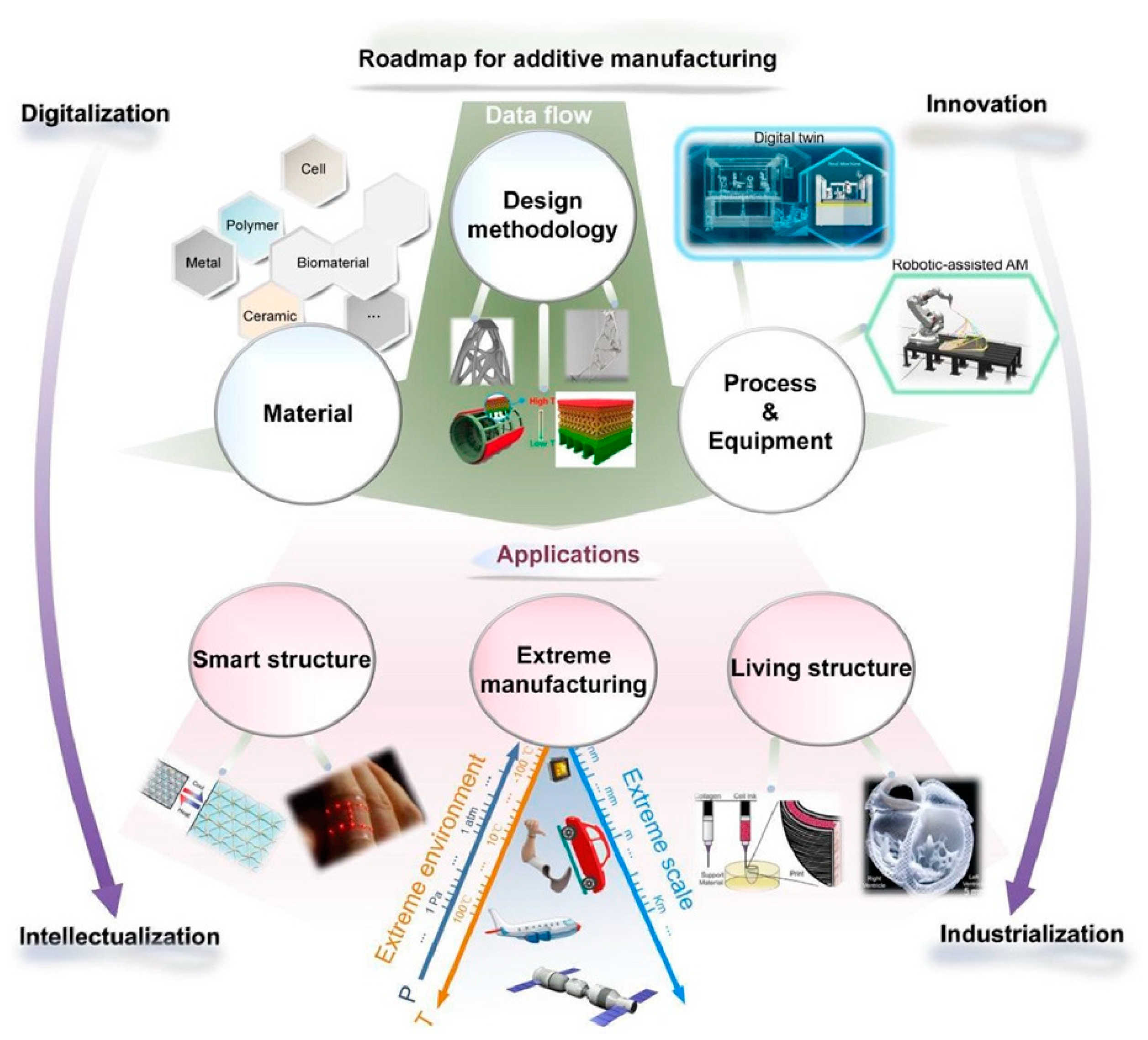

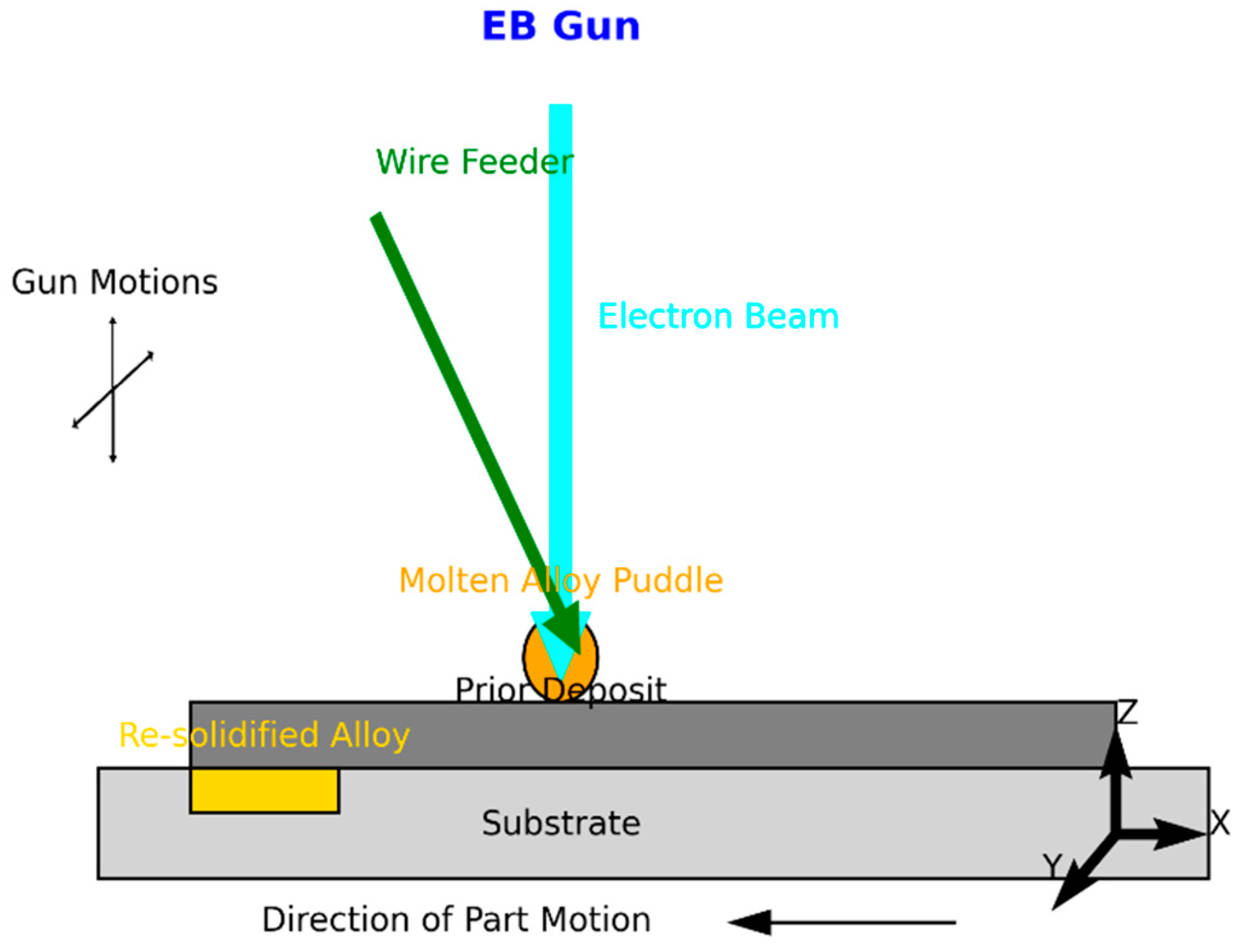

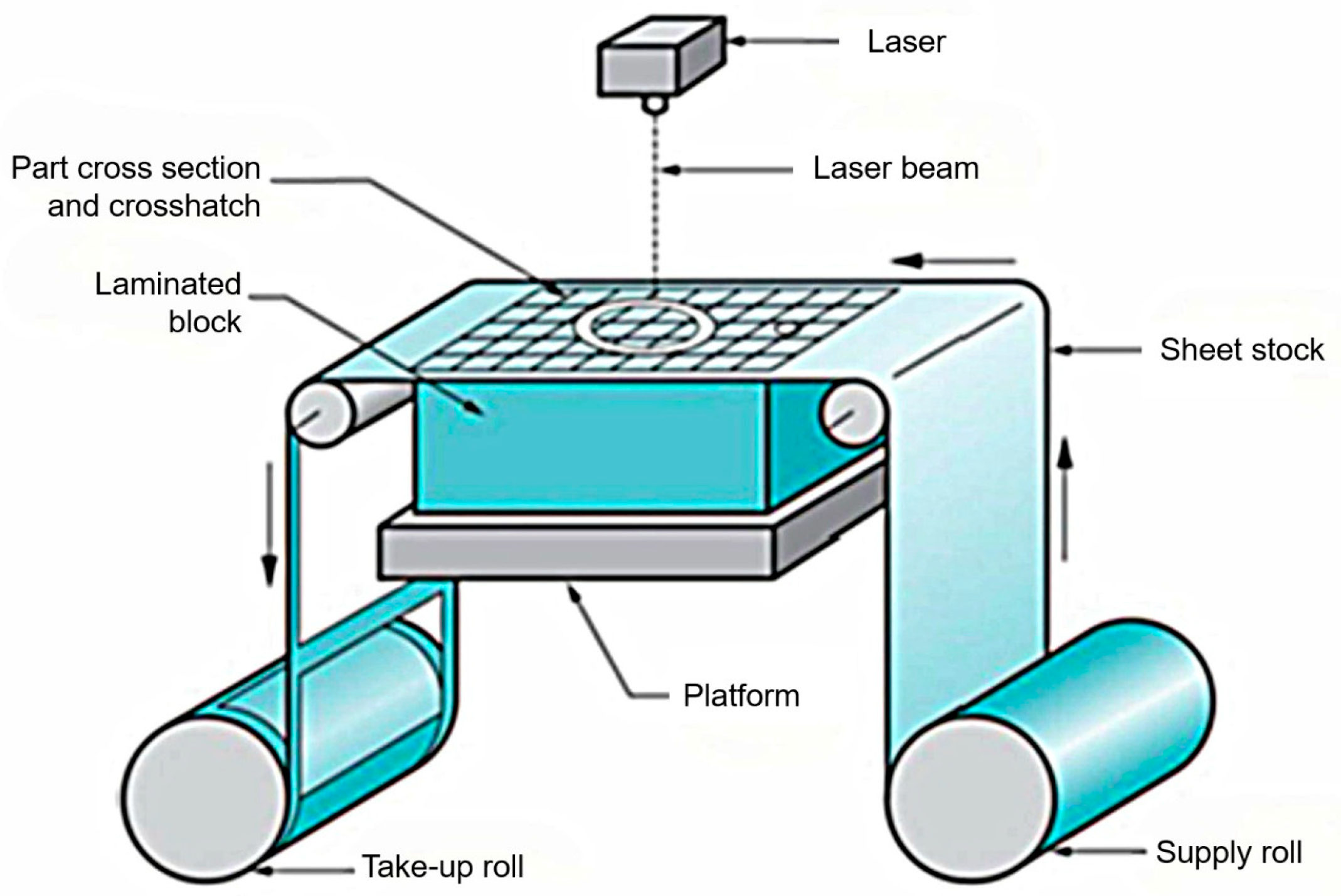

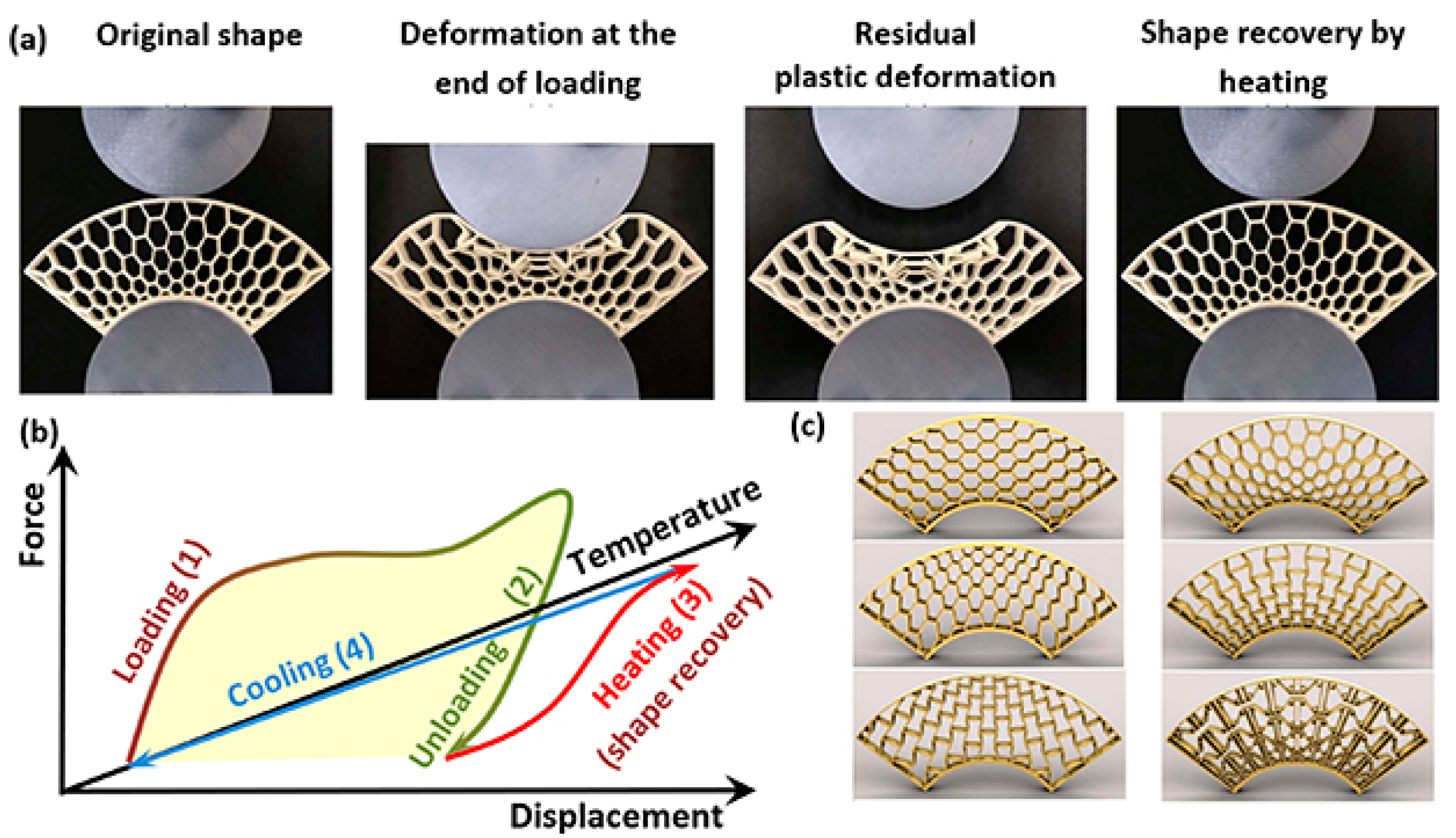

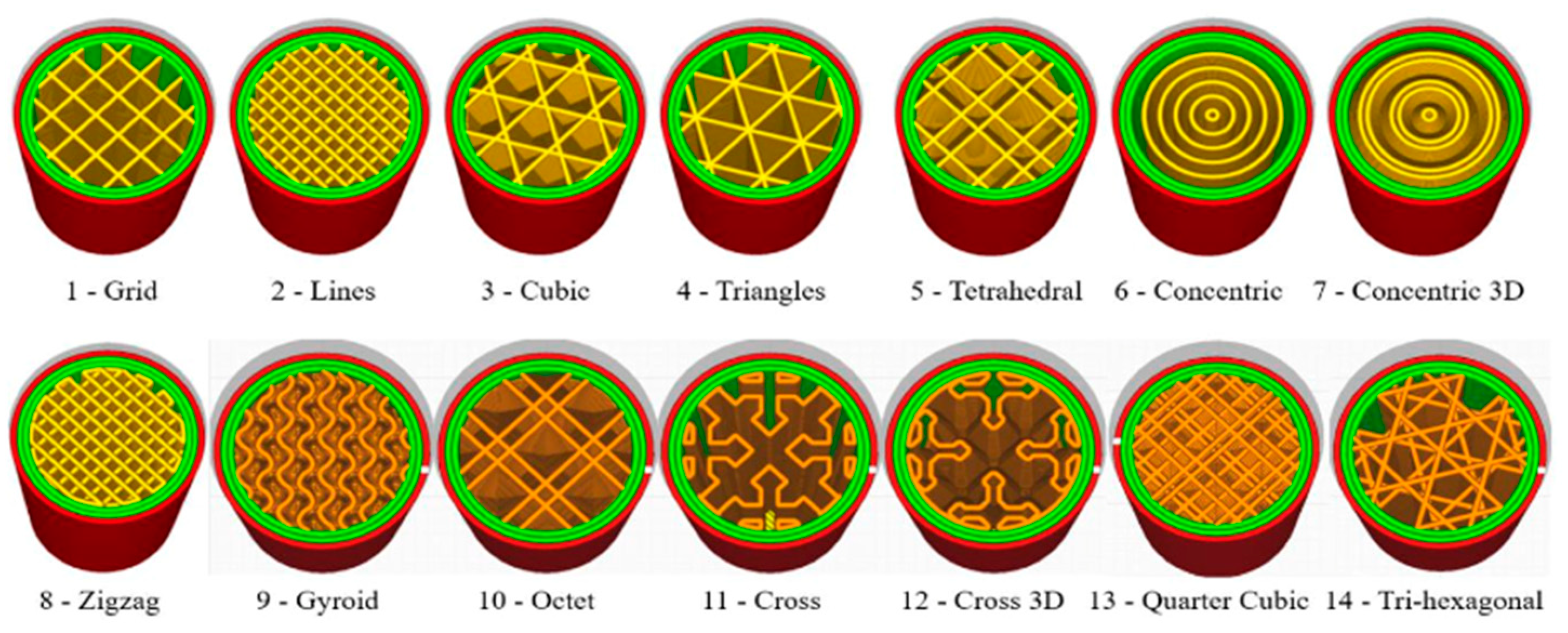
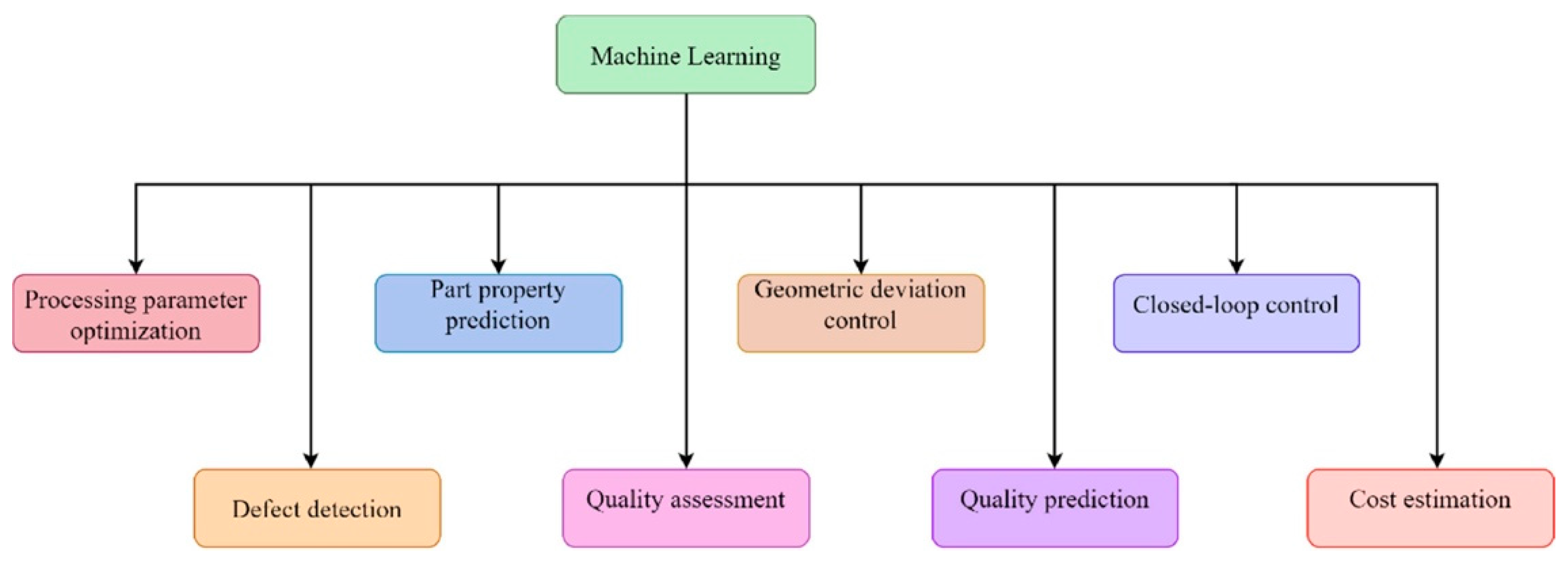

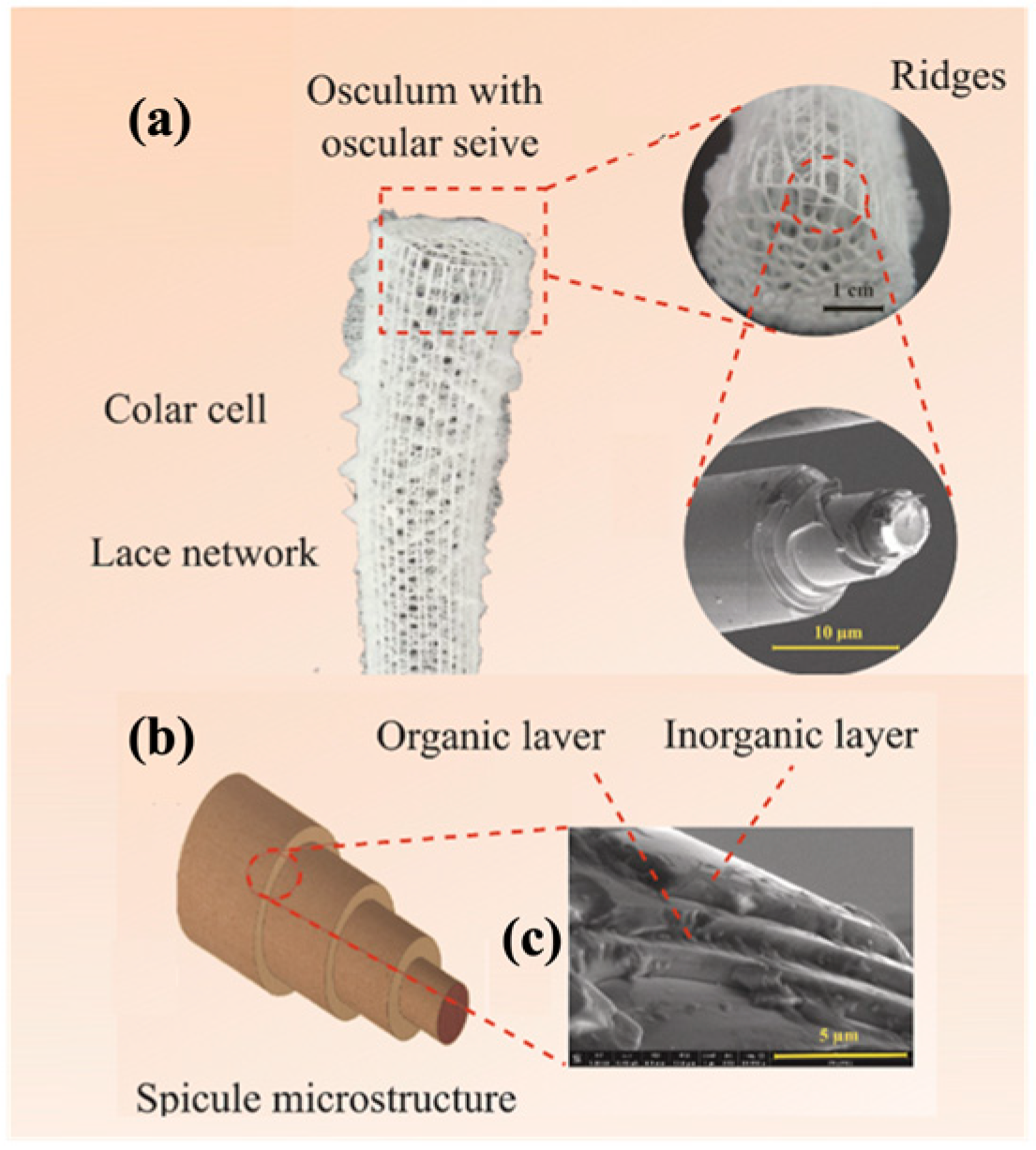

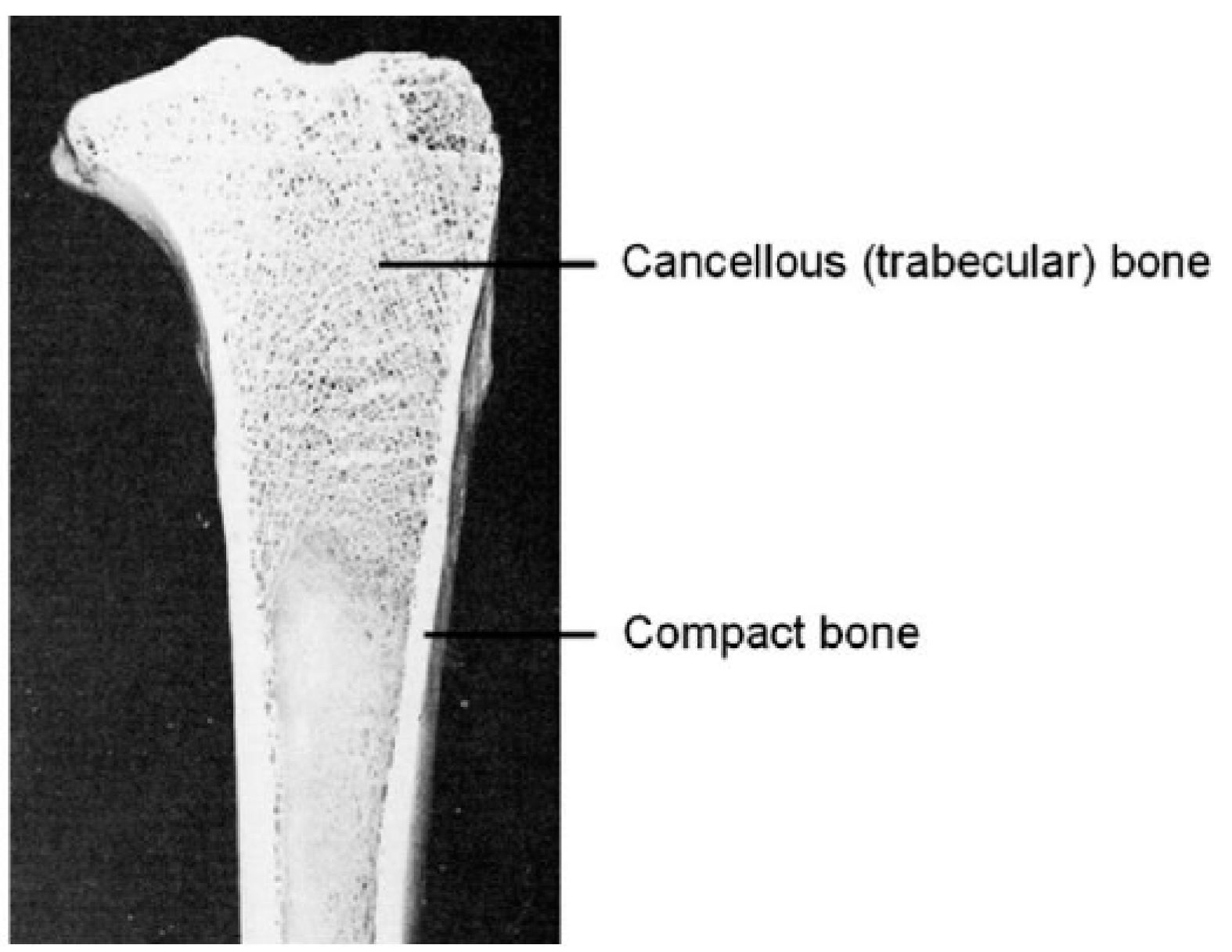
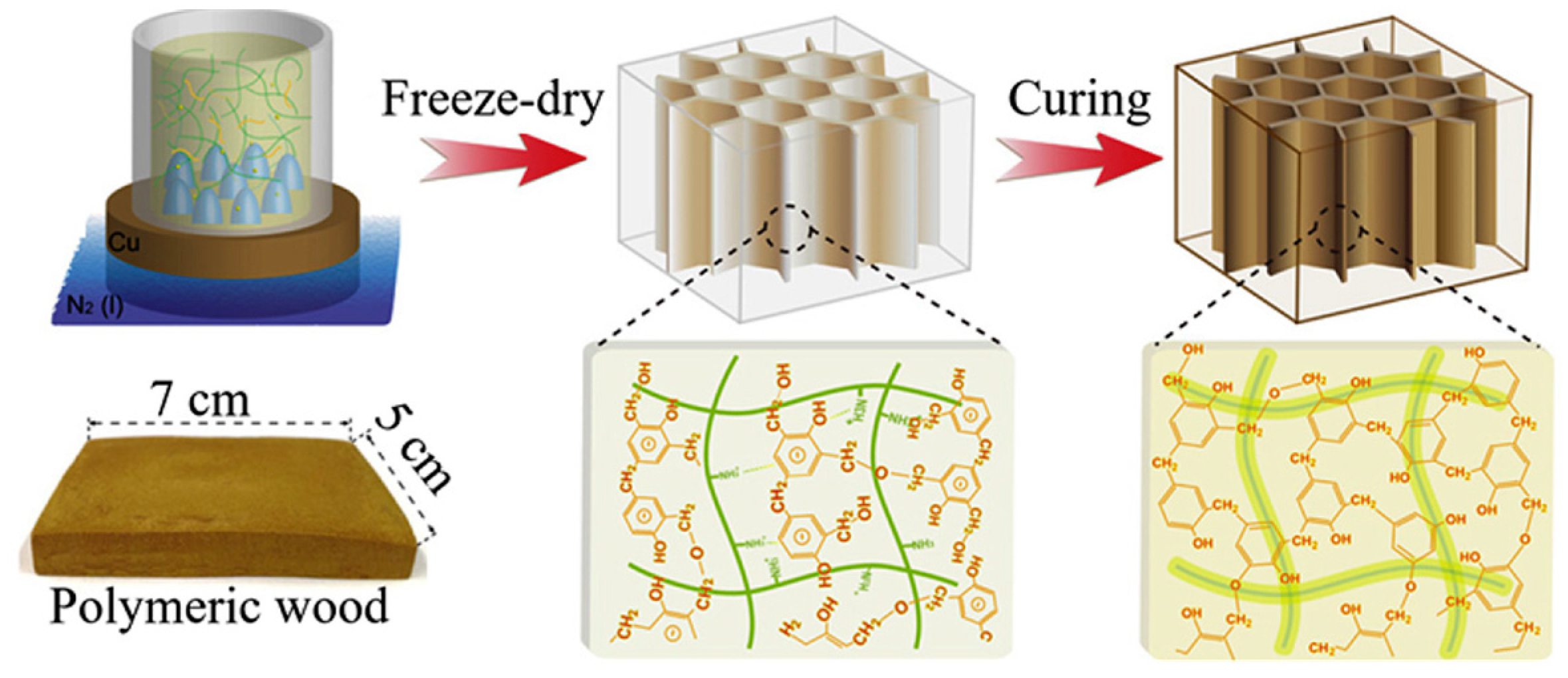
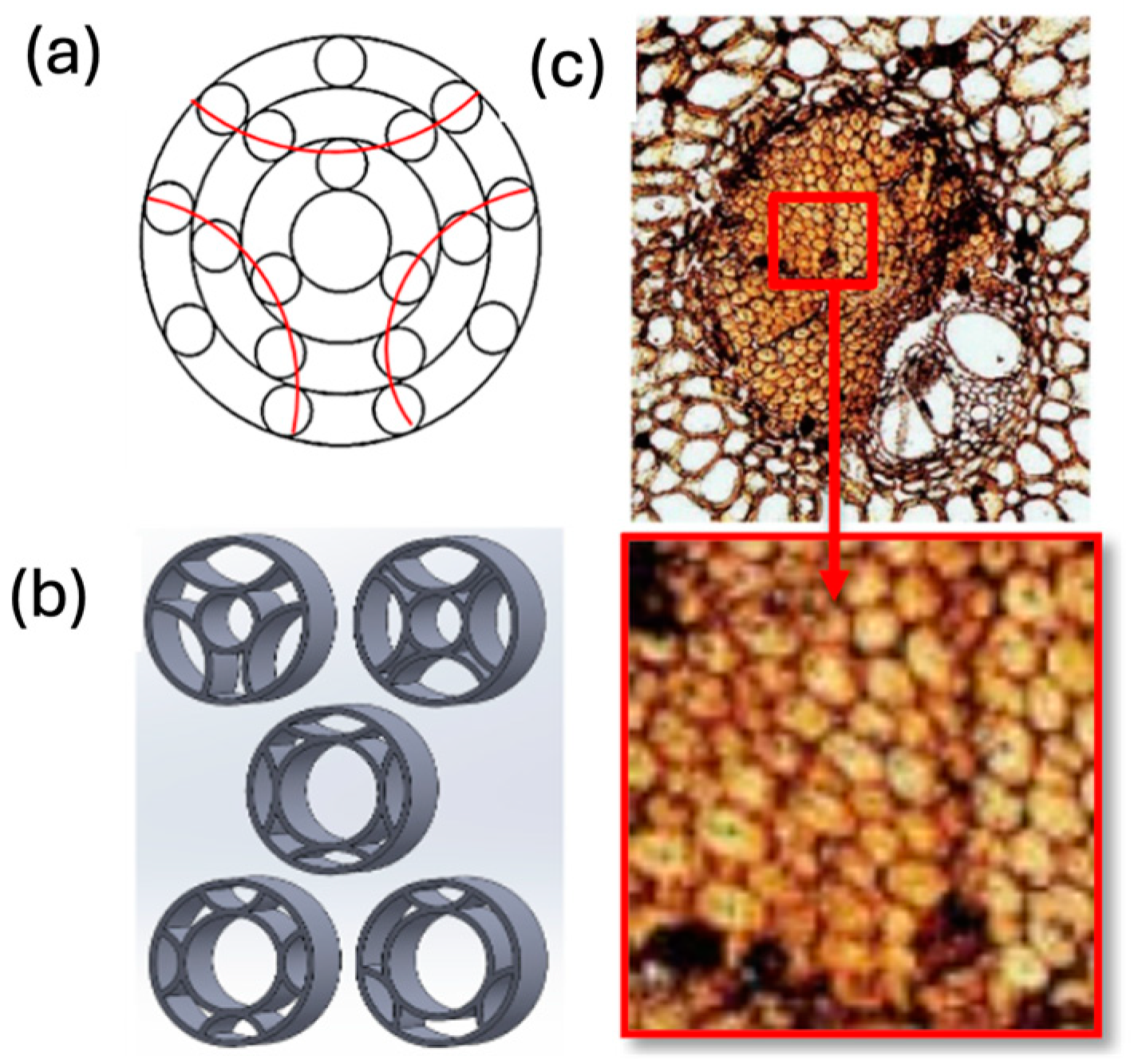
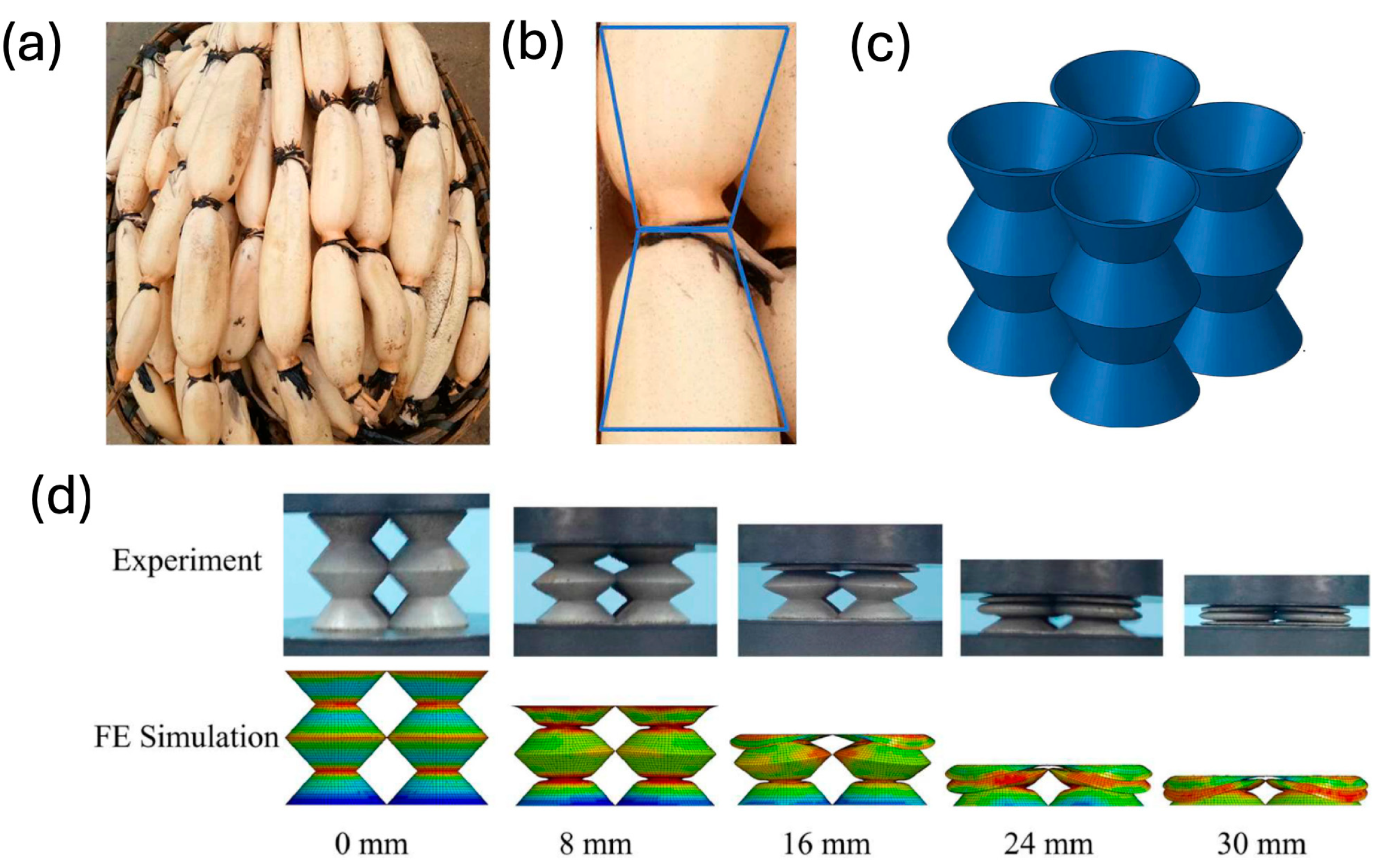
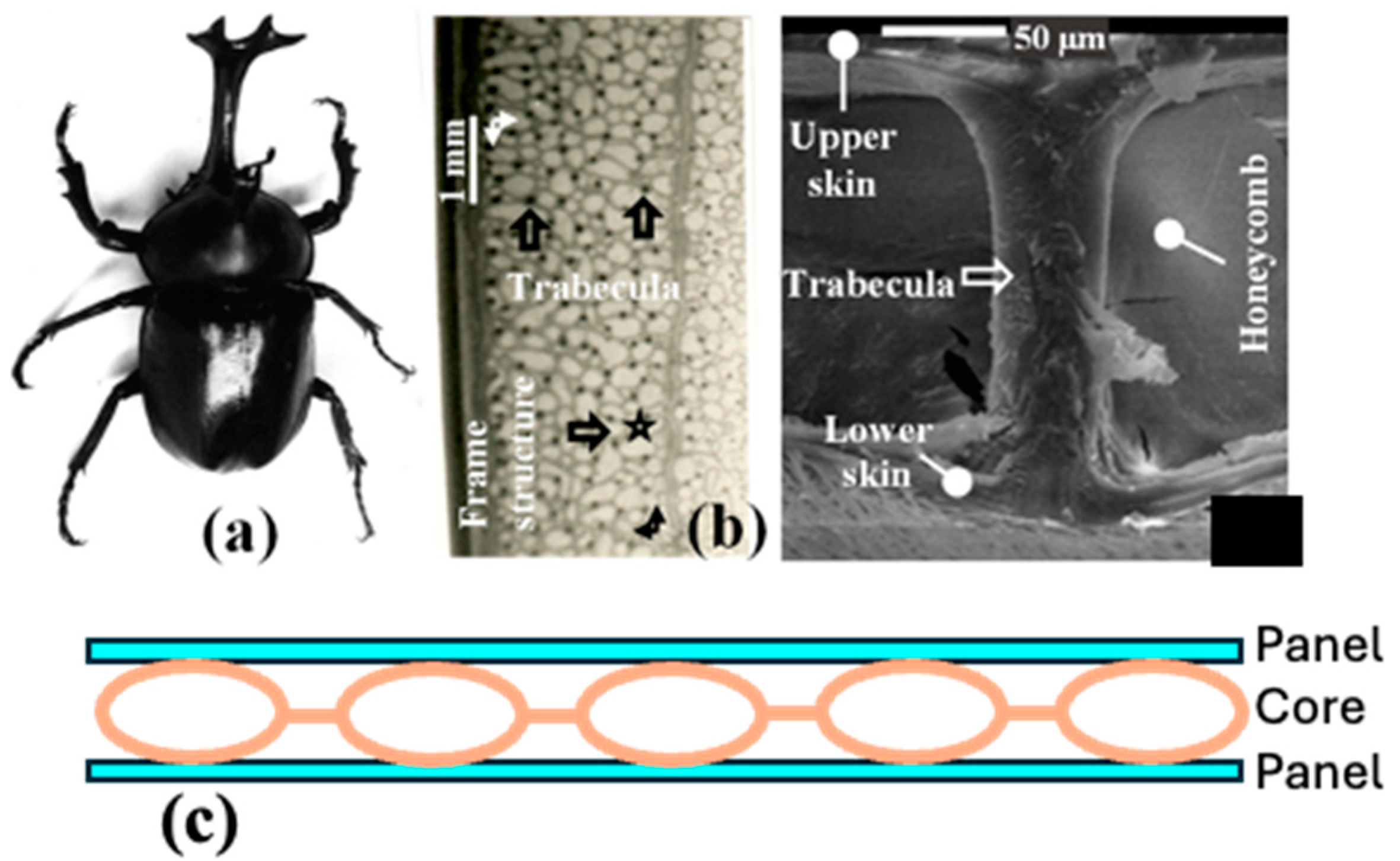
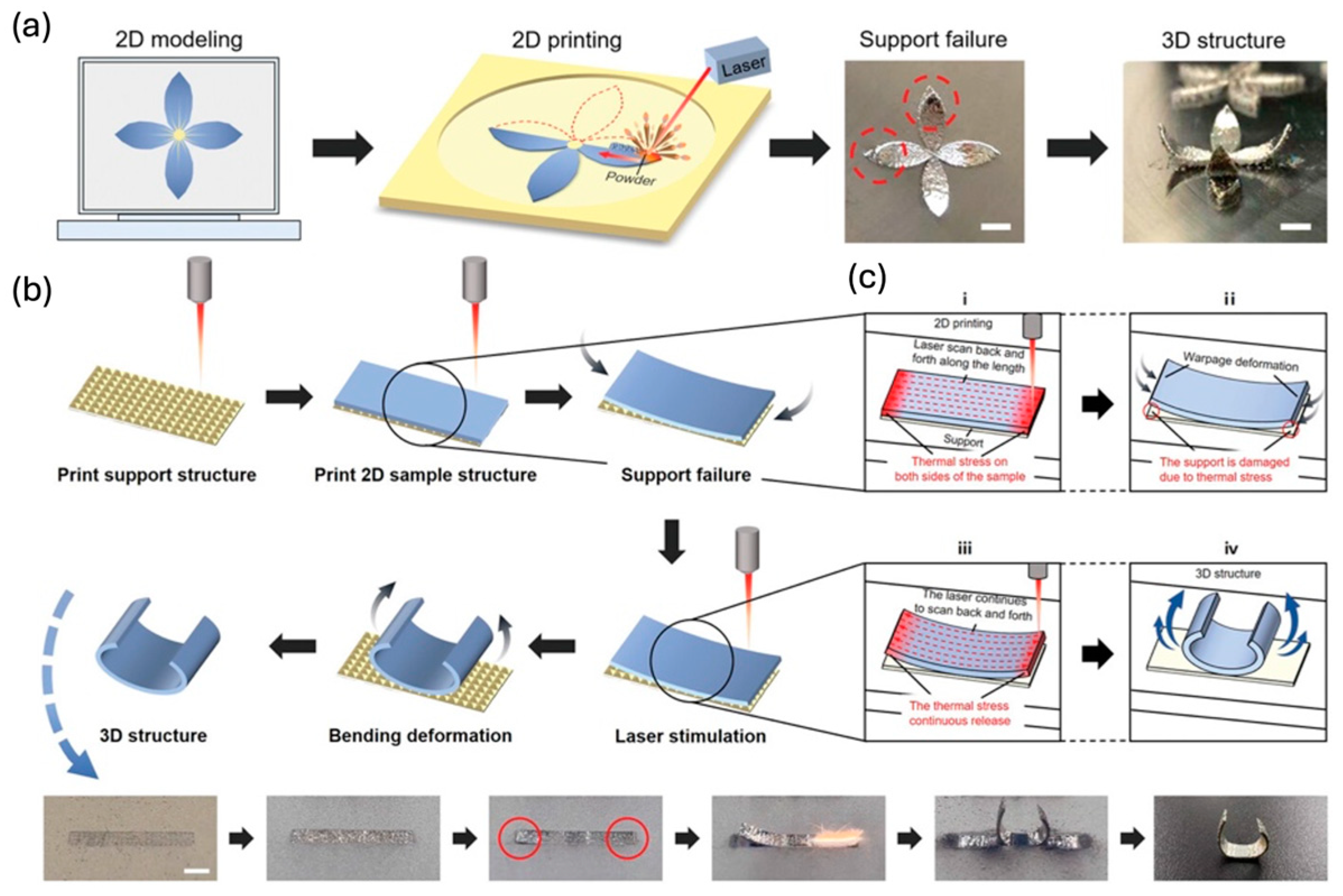
| Methods | Materials | Applications | Benefits | Drawbacks | Printing Resolution Range (Z-Direction) | Maximum Printing Envelope, (L × W × H) |
|---|---|---|---|---|---|---|
| Binder Jetting | Metals: Stainless steel Polymers: ABS, PA Ceramics: Glass | Foundry industries Biomedical | Faster technique No melting Average mechanical strength Low durability | Lack of adhesion between layers Coarse-resolution Time-consuming postprocessing. | 13–16 μm | 1800 × 1000 × 700 mm (e.g., ExOne X1 160Pro) [49]. |
| Directed Energy Deposition | Metals: Cobalt, Chrome, Titanium, Nickel | Aerospace Biomedical | Reduces time and cost Extraordinary mechanical properties Grain structure manipulation Accurate printing | Limited material use. Expensive. Post-processing finishing | 250 μm | Potentially unlimited [65]. |
| Material Extrusion | Polymers: ABS, Nylon, PC, PLA | Rapid prototyping Toys Advanced composites | Low-cost High-speed printing Easiness Average mechanical properties. | Limited materials range. Less accurate. Restricted build volume. Low printing speed. | 50–200 μm | 1000 × 1000 × 1000 mm (e.g., BigRep ONE) [61]. |
| Material Jetting | Polypropylene, HDPE, PS, PMMA | Prototyping Biomedical | Wasteless Thinner printing layers High accuracy | Weak mechanical properties. Lack of adhesion between layers. | 5–200 μm | 490 × 390 × 200 mm (e.g., Stratasys J750) [98]. |
| Power Bed Fusion | SHS: Nylon DMLS, SLS SLM: Stainless Steel, Titanium, Aluminum | Lightweight structures. High performance. engineering parts | High-quality printing. Fine resolution Good mechanical properties | Size limitations. Costly. High porosity. | 250 μm | 700 × 380 × 580 mm (e.g., EOS P 770 for SLS) [99]. |
| Sheet Lamination | Polymer composites Ceramics Paper Metal-filled tapes Metal rolls | Paper industry Electronics Smart structures Ultrasonic welding | Ability to produce larger structures. Inexpensive process. Environmental friendless. | Complex shapes limitations. Low dimensional accuracy and strength. Frequency bonding of different materials | Variable thickness depends on laminates. | 1000 × 800 × 500 mm (e.g., Fabrisonic SonicLayer 7200) [100]. |
| Vat Polymerization | Polymers: UV-curable Photopolymer resin | Medical and dental industries | Better finish High quality | Slow printing High-cost printing setup | 10 μm | 1500 × 750 × 500 mm (e.g., 3D Systems ProX 950) [101]. |
| Materials | Applications | Mechanical Properties | Ultimate Tensile Strength (UTS) | Yield Strength (YS) |
|---|---|---|---|---|
| Stainless Steel 316 | Structural components in construction, automotive exhaust systems, aerospace brackets, food-grade equipment. | High strength, excellent corrosion resistance, suitable for high-stress environments. | 450–705 MPa | 415–590 MPa |
| Aluminum Alloys AlSi10Mg | Aerospace fuselage components, automotive engine parts, lightweight frames, heat exchangers. | Low density, good corrosion resistance, moderate strength. | 350–450 MPa | 200–300 MPa |
| Nickel Alloys IN718 | Turbine blades, jet engine components, combustion chambers, heat shields. | High temperature resistance, excellent fatigue performance. | 414–941 MPa | 352–580 MPa |
| Cobalt-Chromium Alloys Co-Cr-Nio HEA | Dental implants, orthopedic joints, cranial plates. | High wear resistance, biocompatibility. | 730–840 MPa | 500–620 MPa |
| Titanium Alloys Ti-6Al-4V | Aerospace engine casings, structural airframe parts, biomedical hip and knee implants. | High strength-to-weight ratio, excellent biocompatibility. | 900–1100 MPa | 800–1000 MPa |
| Tool Steels H13 | Injection molding tools, cutting tools, dies for metal forming. | High hardness, wear resistance. | 1300–1600 MPa | 1000–1200 MPa |
| Copper Alloys | Electrical connectors, cooling plates, heat exchangers, rocket engine nozzles. | High thermal and electrical conductivity. | 200–300 MPa | 100–200 MPa |
| Element | Properties | Impact on SMAs | Applications | References |
|---|---|---|---|---|
| Copper (Cu) | Lowers transformation temperatures, enhances thermal stability, improves corrosion resistance, and reduces production costs. | Used in Cu-Al-Ni, NiTiCu, and alloys produces exceptional SME with recoverable strains over 50% | Various, especially where lower activation temperatures are needed Aerospace actuators and sensors. | [134,135] |
| Iron (Fe) | Improves corrosion resistance and enhances stability at high temperatures. Modifies transformation behavior and improves fatigue resistance. | Produces NiTiFe alloys, suitable for high-temp applications. Fe-Mn-Si for smart structures. | Aerospace actuators and other high-temp applications. Smart structures, bridges, and damping systems. | [134,136] |
| Manganese (Mn) | Enhances shape memory properties and decreases hysteresis. Refines grain structure and stabilizes martensitic transformation | Allows temperature adjustment during transformation, improves biocompatibility | Medical applications, others requiring precise temperature transformations | [134] |
| Aluminum (Al) | Increases mechanical strength, improves resistance to attrition Reduces density for lightweight applications, | Used in NiTiAl alloys for high mechanical performance applications | Robotics, medical devices implants. Seismic applications. aerospace, automotive, and lightweight | [134,137] |
| Vanadium (V) | Enhances mechanical properties and high-temperature stability. Strengthens the SMA matrix, improves wear resistance, and refines microstructure. | Used in high-strength NiTi-V. Used in high-temp applications, affects phase transformation temperatures | Fire safety systems, automotive components | [134,138] |
| Zirconium (Zr) | Decreases hysteresis, enhances corrosion resistance and increases work output | Found in NiTi-Zr. Enhances superelasticity and shape memory characteristics of NiTiZr alloys | Medical and aerospace applications | [134,139] |
| Tantalum (Ta) | Exceptional corrosion resistance, high strength | Potential for high-temperature SMAs; affects fatigue life | Orthodontic wires, medical implants | [134] |
| Gallium (Ga) | Low-temperature actuation capabilities. Increases ductility and enhances shape recovery properties. | Used in NiTi-Ga. Suitable for self-healing materials and microscale actuators | Applications requiring low-temp actuation | [134,140] |
| Hafnium (Hf) | Enhances high-temperature performance and phase stability | Used in high-temp applications, improves surface integrity and abrasion resistance | High-temperature stability required applications | [134] |
| Silicon (Si) | Improves mechanical properties, enhances resistance to attrition | Found in Fe-Mn-Si-based and used in NiTiSi alloys for applications requiring high mechanical strength | Robotics, aerospace applications | [134,141] |
| Infill Pattern | Grid | Lines | Cubic | Triangles | Tetrahedral | Concentric | Concentric 3D |
|---|---|---|---|---|---|---|---|
| Description | Crisscross pattern with perpendicular lines forming squares. | Parallel lines printed along the X or Y-axis in each layer. | 3D grid of cubes oriented with one corner down, creating air pockets. | Interconnected triangles forming a honeycomb-like structure. | Stacked tetrahedrons for supporting vertical pressure and stress. | Traces model perimeters, creating concentric shapes toward the center. | Extends the concentric pattern into three dimensions. |
| Key Feature | Moderate strength, economical material usage, suitable for general-purpose prints. | Fast to print, uses minimal material, ideal for decorative and calibration prints. | Solid strength, good insulation properties, moderate print time, and material usage. | Excellent structural integrity evenly distributes forces, strong and durable. | High strength, increased material usage, longer print times. | Flexible, allows stretching and twisting, good for flexible parts. | Additional support and strength, suitable for complex geometries. |
| Benefits | High strength-to-weight ratio; performs well under compressive loading. | Maximizes tensile strength when aligned with load direction. | Good for tensile and flexural applications; consistent stress–strain relationships. | Excellent compressive strength and rigidity. | Isotropic strength; ideal for complex geometries. | Efficient under compressive loads; high strength-to-weight ratio. | Provides isotropic strength, suitable for multi-directional loads. |
| Drawbacks | Limited for isotropic stress conditions; 2D nature restricts versatility. | Less effective for multi-directional loads. | Lower strength-to-weight ratio than simpler patterns. | Less effective in tensile applications. | High material consumption compared to 2D patterns. | Limited in applications needing isotropic support. | Lower strength-to-weight ratio compared to 2D patterns. |
| Infill Pattern | Zigzag | Gyroid | Octet | Cross | Cross 3D | Quarter Cubic | Tri-Hexagonal |
| Description | Continuous, uninterrupted line forming a zigzag pattern per layer. | Alternating cresting waves in 3D layers. | Similar to tetrahedrals, stacked tetrahedrons provide strength and stress resistance. | Grid of crosses with hollow centers. | 3D angled version of Cross pattern for more rigid parts. | Offset pyramidal shapes combining Cubic and Octet elements. | Mix of large hexagons and smaller triangles forming star-like patterns. |
| Key Feature | Fast to print, low material usage, lower strength, suitable for decorative items. | Excellent strength in all directions, great for flexible but slightly rigid parts. | High strength, good vertical pressure resistance, uses more filament. | Retains structural integrity under stretching, bending, and twisting, suitable for flexible parts. | Slightly more rigid than standard Cross infill. | Strong with good bonding, uses more material. | Balanced strength and material usage, economical for parts needing moderate resistance to force. |
| Benefits | Moderate strength-to-weight ratio; efficient at lower densities. | Excellent isotropic strength; smooth strain distribution; ideal for complex geometries. | High structural rigidity; ideal for isotropic stress scenarios. | High strength-to-weight ratio for compressive loads among 2D patterns. | Enhanced isotropic properties for complex loads. | Suitable for lightweight and moderately complex geometries. | High strength-to-weight ratio; efficient for compressive loading. |
| Drawbacks | Inferior compressive strength compared to uniform patterns. | Lower compressive strength than 2D patterns. | High material usage; less efficient for unidirectional loads. | Limited tensile alignment; less effective for multidirectional loading. | Uses more material than simpler patterns. | Lower strength-to-weight ratio compared to simpler patterns. | Limited applicability in tensile or isotropic loading scenarios. |
| Additive Manufacturing Method | Bio-Inspired Structure | Purpose | Visual Representation | Reference |
|---|---|---|---|---|
| Material Extrusion (ME) | Spider web-inspired structures, bamboo-like lattices, and hollow tubes. | Utilizing the hierarchical and heterogeneous design of structures with enhanced toughness, impact resistance, and flexibility. |  Spider web-inspired structure | [182,183] |
| Binder Jetting (BJ) | Nacre (mother-of-pearl) and Bouligand structures: | Enhances impact resistance and energy absorption through hierarchical organization. Mimicking the helicoidal arrangements found in mantis shrimp’s dactyl. |  Bouligand structure | [223] |
| Directed Energy Deposition (DED) | Bone-like structures and porous structures. | Provides a high strength-to-weight ratio and material efficiency. | 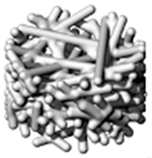 Porous structure | [224] |
| Material Jetting (MJ) | Squid beak gradient structures, lotus leaf-inspired hydrophobic surfaces | Enables parts with varying mechanical properties, improving functionality. | 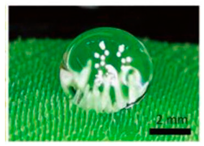 Hydrophobic lotus leaf | [225] |
| Powder Bed Fusion (PBF) | Bird bone-like lightweight structures. Natural cellular materials (metamaterials) | Optimizes strength-to-weight ratios and incorporates internal lattices for weight reduction. Natural cellular materials to achieve ultralight and ultrastiff properties. | 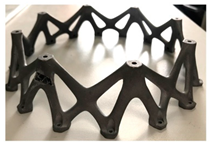 Lightweight structure | [226,227] |
| Sheet Lamination (SL) | Nacre-inspired brick-and-mortar arrangements | Enhances toughness and impact resistance in laminated composites. |  Brick-mortar structure | [228] |
| Vat Photopolymerization (VP) | Wood-like microstructures, porous networks, shark skin-inspired drag-reducing surfaces | Creates lightweight, strong components with applications in fields like biomedical engineering. |  Shark skin-inspired surface | [229] |
Disclaimer/Publisher’s Note: The statements, opinions and data contained in all publications are solely those of the individual author(s) and contributor(s) and not of MDPI and/or the editor(s). MDPI and/or the editor(s) disclaim responsibility for any injury to people or property resulting from any ideas, methods, instructions or products referred to in the content. |
© 2025 by the authors. Licensee MDPI, Basel, Switzerland. This article is an open access article distributed under the terms and conditions of the Creative Commons Attribution (CC BY) license (https://creativecommons.org/licenses/by/4.0/).
Share and Cite
Ramos, A.; Angel, V.G.; Siqueiros, M.; Sahagun, T.; Gonzalez, L.; Ballesteros, R. Reviewing Additive Manufacturing Techniques: Material Trends and Weight Optimization Possibilities Through Innovative Printing Patterns. Materials 2025, 18, 1377. https://doi.org/10.3390/ma18061377
Ramos A, Angel VG, Siqueiros M, Sahagun T, Gonzalez L, Ballesteros R. Reviewing Additive Manufacturing Techniques: Material Trends and Weight Optimization Possibilities Through Innovative Printing Patterns. Materials. 2025; 18(6):1377. https://doi.org/10.3390/ma18061377
Chicago/Turabian StyleRamos, Arturo, Virginia G. Angel, Miriam Siqueiros, Thaily Sahagun, Luis Gonzalez, and Rogelio Ballesteros. 2025. "Reviewing Additive Manufacturing Techniques: Material Trends and Weight Optimization Possibilities Through Innovative Printing Patterns" Materials 18, no. 6: 1377. https://doi.org/10.3390/ma18061377
APA StyleRamos, A., Angel, V. G., Siqueiros, M., Sahagun, T., Gonzalez, L., & Ballesteros, R. (2025). Reviewing Additive Manufacturing Techniques: Material Trends and Weight Optimization Possibilities Through Innovative Printing Patterns. Materials, 18(6), 1377. https://doi.org/10.3390/ma18061377






